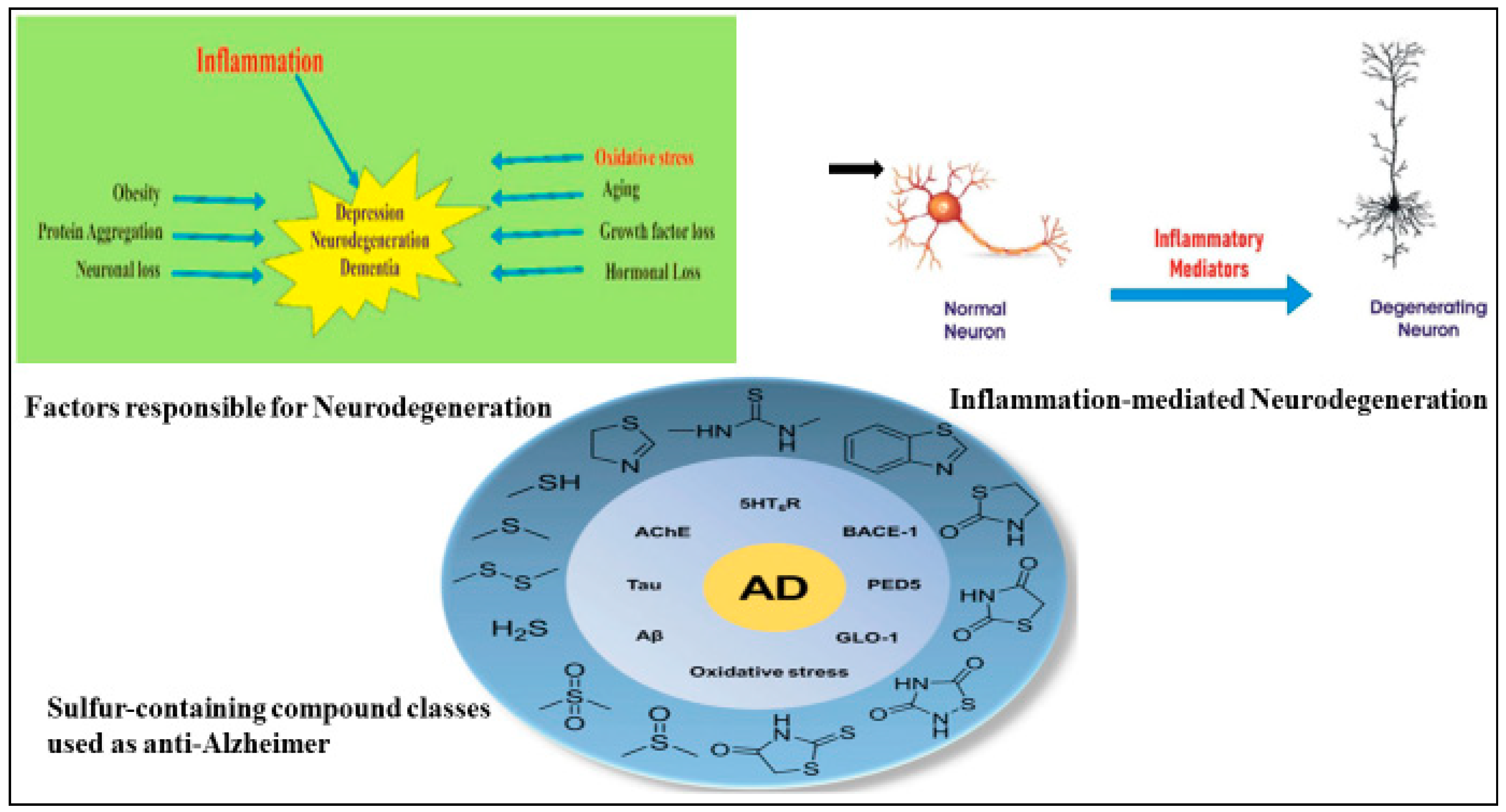Biological Applications of Thiourea Derivatives: Detailed Review
Abstract
1. Introduction
2. Antibacterial Activity

3. Antioxidant Activity
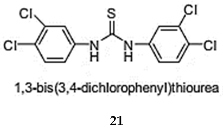
4. Anticancer Activity
5. Anti-Inflammatory Activity
6. Antituberculosis Activity
7. Anti-Alzheimer
8. Antimalarial Activity
9. The Recent Strategies in the Synthesis of Thiourea Derivatives
10. Conclusions
Funding
Data Availability Statement
Conflicts of Interest
References
- Favre, H.A.; Powell, W.H. Nomenclature of Organic Chemistry: IUPAC Recommendations and Preferred Names; IUPAC Blue book; RSC Publishing: London, UK, 2014; ISBN 978-0-85404-182-4. [Google Scholar] [CrossRef]
- Alcolea, V.; Plano, D.; Karelia, D.N.; Palop, J.A.; Amin, S.; Sanmartín, C.; Sharma, A.K. Novel seleno- and thiourea derivatives with potent in vitro activities against several cancer cell lines. Eur. J. Med. Chem. 2016, 113, 134–144. [Google Scholar] [CrossRef] [PubMed]
- Mertschenk, B.; Knott, A.; Bauer, W. Thiourea and thiourea derivatives. In Ullmann’s Encyclopedia of Industrial Chemistry; Wiley: Hoboken, NJ, USA, 2000; Volume 15, pp. 1–15. [Google Scholar]
- Kerru, N.; Settypalli, T.; Nallapaneni, H.C.V. Novel thienopyrimidine derivatives Containing 1,2,4-triazoles and 1,3,4-oxadiazoles as potent antimicrobial activity. Med. Chem. 2014, 4, 623–629. [Google Scholar] [CrossRef]
- Rivera, A.; Maldonado, M.; Ríos-Motta, J. A facile and efficient procedure for the synthesis of new benzimidazole-2-thione derivatives. Molecules 2012, 17, 8578–8586. [Google Scholar] [CrossRef]
- Kulakov, I.; Nurkenov, O.; Akhmetova, S.; Seidakhmetova, R.; Zhambekov, Z. Synthesis and antibacterial and antifungal activities of thiourea derivatives of the alkaloid anabasine. Pharm. Chem. J. 2011, 45, 15–18. [Google Scholar] [CrossRef]
- Mishra, A.; Batra, S. Thiourea and guanidine derivatives as antimalarial and antimicrobial agents. Curr. Top. Med. Chem. 2013, 13, 2011–2025. [Google Scholar] [CrossRef]
- Hasanen, J.; El-Deen, I.; El-Desoky, R.; Abdalla, A. Synthesis of some nitrogen heterocycles and in vitro evaluation of their antimicrobial and antitumor activity. Res. Chem. Interm. 2014, 40, 537–553. [Google Scholar] [CrossRef]
- Pattan, S.; Kedar, M.; Pattan, J.; Dengale, S.; Sanap, M.; Gharate, U.; Shinde, P.; Kadam, S. Synthesis and evaluation of some novel 2,4-thiazolidinedione derivatives for antibacterial, antitubercular, and antidiabetic activities. Indian J. Chem. 2012, 51, 1421–1425. [Google Scholar] [CrossRef]
- Shivakumara, K.N.; Sridhar, B.T. Review on role of urea and thiourea derivatives of some heterocyclic Scaffold in drug design and medicinal chemistry. Int. J. Chem. Res. Dev. 2021, 3, 20–25. [Google Scholar]
- Riccardo, R.; Giada, M.; Andrea, C.; Antimo, G.; Emidio, C. Recent advances in urea- and thiourea-containing compounds: Focus on innovative approaches in medicinal chemistry and organic synthesis. RSC Med. Chem. 2021, 12, 1046–1064. [Google Scholar]
- Ezzat, K.; Sikandar, K.; Zarif, G.; Mian, M. Medicinal Importance, Coordination Chemistry with Selected Metals (Cu, Ag, Au) and Chemosensing of Thiourea Derivatives. A Review. Crit. Rev. Anal. Chem. 2021, 51, 812–834. [Google Scholar]
- Sumaira, N.; Muhammad, Z.; Muhammad, N.U.; Saad, A.; Muhammad, U.K.S.; Wasim, U. Synthesis, characterization, and pharmacological evaluation of thiourea derivatives. Open Chem. 2020, 18, 764–777. [Google Scholar]
- Roxana, R.; Lucia, P.; Miron, T.; Căproiu, F.; Dumitras, C.; Diana, C.N.; Irina, Z.; Petre, I.; Mariana, C.C.; Cornel, C.; et al. New N-acyl Thiourea Derivatives: Synthesis, Standardized Quantification Method and In Vitro Evaluation of Potential Biological Activities. Antibiotics 2023, 12, 807. [Google Scholar] [CrossRef]
- Saghi, S.; Ghorbani, N.M.; Masoud, M.Z.; Masood, G. Synthesis and Investigation of the Antibacterial Activity of New Tris-thiourea Derivatives. Pharm. Chem. J. 2021, 55, 36–40. [Google Scholar]
- Mumtaz, J.; Arshad, A.; Saeed, M.A.H.; Nawaz, J. Iqbal. Synthesis, characterization and urease inhibition studies of transition metal complexes of thioureas bearing ibuprofen moiety. J. Chil. Chem. Soc. 2018, 63, 3934–3940. [Google Scholar] [CrossRef]
- Ahmed, T.F.A.; Adnan, A.H.; Ahmed, S.F.; Abdulrahman, M.S.; Tarek, A.Y.; Mortaga, M.A.; Mona, H.A.; Ahmed, S.M.A. Thiourea Derivative Metal Complexes: Spectroscopic, Anti-Microbial Evaluation, ADMET, Toxicity, and Molecular Docking Studies. Inorganics 2023, 11, 390. [Google Scholar] [CrossRef]
- Aleksandra, D.; Marta, S.; Agnieszka, G.; Ewa, A.; Katarzyna, D.; Alicja, C.; Anna, W.; Paweł, R.; Marcin, T.K.; Małgorzata, W.; et al. Synthesis, Structural Characterization and Biological Activity Evaluation of Novel Cu (II) Complexes with 3-(trifluoromethyl)phenylthiourea Derivatives. Int. J. Mol. Sci. 2022, 23, 15694. [Google Scholar] [CrossRef]
- Bielenica, A.; Stefańnska, J.; Stępień, K.; Napiórkowska, A.; Augustynowicz-Kopeć, E.; Sanna, G.; Madeddu, S.; Boi, S.; Giliberti, G.; Wrzosek, M. Synthesis, cytotoxicity, and antimicrobial activity of thiourea derivatives incorporating 3-(trifluoromethyl)phenyl moiety. Eur. J. Med. Chem. 2015, 101, 111–125. [Google Scholar] [CrossRef]
- Stefańska, J.; Stępień, K.; Bielenica, A.; Wrzosek, M.; Struga, M. Antistaphylococcal Activity of Selected Thiourea Derivatives. Pol. J. Microbiol. 2016, 65, 451–460. [Google Scholar] [CrossRef] [PubMed]
- Bielenica, A.; Stępień, K.; Napiórkowska, A.; Augustynowicz-Kopeć, E.; Krukowski, S.; Włodarczyk, M.; Struga, M. Synthesis and Antimicrobial Activity of 4-Chloro-3-Nitrophenylthiourea Derivatives Targeting Bacterial Type II Topoisomerases. Chem. Biol. Drug Des. 2016, 87, 905–917. [Google Scholar] [CrossRef] [PubMed]
- Sudzhaev, R.; Rzaeva, I.A.; Nadzhafova, R.A.; Safarov, Y.S.; Allakhverdiev, M.A. Antioxidant properties of some thiourea derivatives. Russ. J. Appl. Chem. 2011, 84, 1394–1397. [Google Scholar] [CrossRef]
- Litvinov, V.P. Thienopyrimidines: Synthesis, properties, and biological activity. Russ. Chem. Bull. 2004, 53, 487–516. [Google Scholar] [CrossRef]
- Abdullah, Q.O.; Oday, H.R.A.; Sudad, A.D. Synthesis, Characterization of Some Thiourea Derivatives Based on 4-Methoxybenzoyl Chloride as Antioxidants and Study of Molecular Docking. Iraqi J. Sci. 2023, 64, 1–12. [Google Scholar]
- Lv, P.C.; Li, H.-Q.; Sun, J.; Zhou, Y.; Zhu, H.-L. Synthesis and biological evaluation of pyrazole derivatives containing thiourea skeleton as anticancer agents. Bioorg. Med. Chem. 2010, 18, 4606–4614. [Google Scholar] [CrossRef] [PubMed]
- Saeed, S.; Rashid, N.; Jones, P.G.; Ali, M.; Hussain, R. Synthesis, characterization and biological evaluation of some thiourea derivatives bearing benzothiazole moiety as potential antimicrobial and anticancer agents. Eur. J. Med. Chem. 2010, 45, 1323–1331. [Google Scholar] [CrossRef] [PubMed]
- Manjula, S.; Noolvi, N.M.; Parihar, K.V.; Reddy, S.M.; Ramani, V.; Gadad, A.K.; Singh, G.; Kutty, N.G.; Rao, C.M. Synthesis and antitumor activity of optically active thiourea and their 2-aminobenzothiazole derivatives: A novel class of anticancer agents. Eur. J. Med. Chem. 2009, 44, 2923–2929. [Google Scholar] [CrossRef] [PubMed]
- Kumar, V.; Chimni, S.S. Recent developments on thiourea-based anticancer chemotherapeutics. Anti-Cancer Agents Med. Chem. 2015, 15, 163–175. [Google Scholar] [CrossRef] [PubMed]
- Ghorab, M.M.; El-Gaby, M.S.A.; Alsaid, M.S.; Elshaier, Y.A.M.M.; Soliman, A.M.; El-Senduny, F.F.; Badria, F.A.; Sherif, A.Y.A. Novel thiourea derivatives bearing sulfonamide moiety as anticancer agents through COX-2 inhibition. Anti-Cancer Agents Med.Chem. (Former. Curr. Med. Chem. Anti-Cancer Agents) 2017, 17, 1411–1425. [Google Scholar] [CrossRef] [PubMed]
- Perez, S.A.; de Haro, C.; Vicente, C.; Donaire, A.; Zamora, A.; Zajac, J.; Kostrhunova, H.; Brabec, V.; Bautista, D.; Ruiz, J. New acridine thiourea gold (I) anticancer agents: Targeting the nucleus and inhibiting vasculogenic mimicry. ACS Chem. Biol. 2017, 12, 1524–1537. [Google Scholar] [CrossRef] [PubMed]
- Tokala, R.; Bale, S.; Janrao, I.P.; Vennela, A.; Kumar, N.P.; Senwar, K.R.; Shankaraiah, N. Synthesis of 1,2,4-triazole-linked urea/thiourea conjugates as cytotoxic and apoptosis-inducing agents. Bioorg. Med. Chem. Lett. 2018, 28, 1919–1924. [Google Scholar] [CrossRef]
- Abbas, S.Y.; Al-Harbi, R.A.; El-Sharief, M.A.S. Synthesis and anticancer activity of thiourea derivatives bearing a benzodioxole moiety with EGFR inhibitory activity, apoptosis assay and molecular docking study. Eur. J. Med. Chem. 2020, 198, 112363. [Google Scholar] [CrossRef]
- Jin, J.; Hu, J.; Qin, Y.; Zhang, J.; Yue, L.; Hou, H. In vitro and in vivo anticancer activity of a thiourea tripyridyl dinuclear Cu (ii) complex. New J. Chem. 2019, 43, 19286–19297. [Google Scholar] [CrossRef]
- Kaur, B.; Singh, G.; Sharma, V.; Singh, I. Sulphur Containing Heterocyclic Compounds as Anticancer Agents. Anticancer Agents Med. Chem. 2023, 23, 869–881. [Google Scholar]
- Liao, P.; Hu, S.-Q.; Zhang, H.; Xu, L.-B.; Liu, J.Z.; He, B.; Liao, S.G.; Li, Y.J. Study on antiproliferative activity in cancer cells and preliminary structure–activity relationship of pseudo peptide chiral thioureas. Bull. Korean Chem. Soc. 2018, 39, 300–304. [Google Scholar] [CrossRef]
- Pingaew, R.; Sinthupoom, N.; Mandi, P.; Prachayasittikul, V.; Cherdtrakulkiat, R.; Prachayasittikul, S.; Ruchirawat, S.; Prachayasittikul, V. Synthesis, biological evaluation and in silico study of bis-thiourea derivatives as anticancer, antimalarial and antimicrobial agents. Med. Chem. Res. 2017, 26, 3136–3148. [Google Scholar] [CrossRef]
- Hu, H.; Lin, C.; Ao, M.; Ji, Y.; Tang, B.; Zhou, X.; Fang, M.; Zeng, J.; Wu, Z. Synthesis and biological evaluation of 1-(2-(adamantane-1-yl)-1:H-indol-5-yl)-3-substituted urea/thiourea derivatives as anticancer agents. RSC Adv. R. Soc. Chem. 2017, 7, 51640–51651. [Google Scholar] [CrossRef]
- Samuel, J.; Thomas, B.B.; Jindrich, C.; Mark, N.W.; Christopher, J.S.; Barry, A.B.; Martin, M. Thiourea and Guanidine Compounds and their Iridium Complexes in Drug-Resistant Cancer Cell Lines: Structure-Activity Relationships and Direct Luminescent Imaging. ChemMedChem. 2020, 15, 349–353. [Google Scholar]
- Casini, A.; Messori, L. Molecular Mechanisms and Proposed Targets for Selected Anticancer Gold Compounds. Curr. Top. Med. Chem. 2011, 11, 2647–2660. [Google Scholar] [CrossRef] [PubMed]
- Zou, T.; Lum, C.T.; Lok, C.-N.; Zhang, J.-J.; Che, C.-M. Chemical biology of anticancer gold (III) and gold(I) complexes. Chem. Soc. Rev. 2015, 44, 8786–8801. [Google Scholar] [CrossRef] [PubMed]
- Mora, M.; Gimeno, M.C.; Visbal, R. Recent advances in gold-NHC complexes with biological properties. Chem. Soc. Rev. 2019, 48, 447–462. [Google Scholar] [CrossRef]
- Ott, I.; Quian, X.; Xu, Y.; Vlecken, D.H.W.; Marques, I.J.; Kubutat, D.; Will, J.; Sheldrick, W.S.; Jesse, P.; Prokop, A.; et al. A Gold(I) Phosphine Complex Containing a Naphthalimide Ligand Functions as a TrxR Inhibiting Antiproliferative Agent and Angiogenesis Inhibitor. J. Med. Chem. 2009, 52, 763–770. [Google Scholar] [CrossRef]
- Gutierrez, A.; Gracia-Fleta, L.; Marzo, I.; Cativiela, C.; Laguna, A.; Gimeno, M.C. Gold(I) thiolates containing amino acid moieties. Cytotoxicity and structure–activity relationship studies. Dalton Trans. 2014, 43, 17054–17066. [Google Scholar] [CrossRef] [PubMed]
- Ronconi, L.; Giovagnini, L.; Marzano, C.; Bettìo, F.; Graziani, R.; Pilloni, G.; Fregona, D. Gold dithiocarbamate derivatives as potential antineoplastic agents: Design, spectroscopic properties, and in vitro antitumor activity. Inorg. Chem. 2005, 44, 1867–1881. [Google Scholar] [CrossRef] [PubMed]
- Quero, J.; Cabello, S.; Fuertes, T.; Mármol, I.; Laplaza, R.; Polo, V.; Gimeno, M.C.; Rodriguz-Yoldi, M.J.; Cerrada, E. Proteasome versus Thioredoxin Reductase Competition as Possible Biological Targets in Antitumor Mixed Thiolate-Dithiocarbamate Gold (III) Complexes. Inorg. Chem. 2018, 57, 10832–10845. [Google Scholar] [CrossRef] [PubMed]
- Berners-Price, S.J.; Sadler, P.J. Gold(I) complexes with bidentate tertiary phosphine ligands: Formation of annular vs. tetrahedral chelated complexes. Inorg. Chem. 1986, 25, 3822–3827. [Google Scholar] [CrossRef]
- Ortego, L.; Laguna, A.; Gonzalo-Asensio, J.; Villacampa, M.D.; Gimeno, M.C. (Aminophosphane)gold(I) and silver(I) complexes as antibacterial agents. J. Inorg. Biochem. 2015, 146, 19–27. [Google Scholar] [CrossRef]
- Baker, M.V.; Barnard, P.J.; Berners-Price, S.J.; Brayshaw, S.K.; Hickey, J.L.; Skelton, B.W.; White, A.H. Cationic, linear Au (I) N-heterocyclic carbene complexes: Synthesis, structure and anti-mitochondrial activity. Dalton Trans. 2006, 3708–3715. [Google Scholar] [CrossRef] [PubMed]
- Gallati, C.M.; Goetzfried, S.K.; Ausserer, M.; Sagasser, J.; Plangger, M.; Wurst, K.; Hermann, M.; Baecker, D.; Kircher, B.; Gust, R. Synthesis, characterization, and biological activity of bromido [3-ethyl-4-aryl-5-(2-methoxypyridin-5-yl)-1-propyl-1,3-dihydro-2Himidazol-2-ylidene] gold(I) complexes. Dalton Trans. 2020, 49, 5471–5481. [Google Scholar] [CrossRef] [PubMed]
- Gallati, C.M.; Goetzfried, S.K.; Ortmeier, A.; Sagasser, J.; Wurst, K.; Hermann, M.; Baecker, D.; Kircher, B.; Gust, R. Synthesis, characterization and biological activity of bis [3-ethyl-4-aryl-5-(2-methoxypyridin-5-yl)-1-propyl-1,3-dihydro-2H-imidazol-2-ylidene] gold(I) complexes. Dalton Trans. 2021, 50, 4270–4279. [Google Scholar] [CrossRef]
- Khodjoyan, S.; Remadna, E.; Dossmann, H.; Lesage, D.; Gontard, G.; Forté, J.; Hoffmeister, H.; Basu, U.; Ott, I.; Spence, P.; et al. [(CC)Au(NN)]+ complexes as a new family of anticancer candidates: Synthesis, characterization and exploration of the antiproliferative properties. Chem. Eur. J. 2021, 27, 15773–15785. [Google Scholar] [CrossRef]
- Guillermo, C.; Lourdes, O.; Anabel, I.; Isabel, M.; Raquel, P.H. Concepción Gimeno. Synthesis of New Thiourea-Metal Complexes with Promising Anticancer Properties. Molecules 2021, 26, 6891. [Google Scholar]
- Banti, C.N.; Giannoulis, A.D.; Kourkoumelis, N.; Owczarzak, A.M.; Poyraz, M.; Kubicki, M.; Charalabopoulos, K.; Hadjikakou, S.K. Mixed ligand–silver(I) complexes with anti-inflammatory agents which can bind to lipoxygenase and calf-thymus DNA, modulating their function and inducing apoptosis. Metallomics 2012, 4, 545–560. [Google Scholar] [CrossRef] [PubMed]
- Pandey, S.K.; Pratap, S.; Rai, S.K.; Marverti, G.; Kaur, M.; Jasinsk, J.P. Synthesis, characterization, Hirshfeld surface, cytotoxicity, DNA damage and cell cycle arrest studies of N, N-diphenyl-N’-(biphenyl-4-carbonyl/4-chlorobenzoyl) thiocarbamides. J. Mol. Struc. 2019, 1186, 333–344. [Google Scholar] [CrossRef]
- Abdel–Hadi, K.A.; Abdel-Razik, A.; Shoukry, M.M.; Shoheib, S.M. Egypt. J. Chem. 1996, 39, 179.
- Saeed, A.; Qamar, R.; Fattah, T.A.; Flörke, U.; Erben, M.F. Recent developments in chemistry, coordination, structure and biological aspects of 1-(acyl/aroyl)-3-(substituted) thioureas. Res. Chem. Intermed. 2017, 43, 3053–3093. [Google Scholar] [CrossRef]
- Yaqeen, M.A.; Rafid, H.A. Synthesis, Anti-breast Cancer Activity, and Molecular Docking Studies of Thiourea Benzamide Derivatives and Their Complexes with Copper Ion. Trop. J. Nat. Prod. Res. 2023, 7, 3158–3167. [Google Scholar]
- Shing, J.C.; Choi, J.; Chapman, R.; Schroeder, M.; Sarkaria, J.; Fauq, A.; Bram, R.J. A novel synthetic 1, 3-phenyl bis-thiourea compound targets microtubule polymerization to cause cancer cell death. Cancer Biol. Ther. 2014, 15, 895–905. [Google Scholar] [CrossRef]
- Nowotarski, S.L.; Pachaiyappan, B.; Holshouser, S.; Kutz, C.; Li, Y.; Huang, Y.; Woster, P. Structure–activity study for (bis) ureidopropyl-and (bis) thioureidopropyldiamine LSD1 inhibitors with 3-5-3 and 3-6-3 carbon backbone architectures. Bioorg. Med. Chem. 2015, 23, 1601–1612. [Google Scholar] [CrossRef] [PubMed]
- Nasima, A.; Uzma, P.; Pervaiz, A.C.; Aamer, S.; Waseem, S.S.; Fouzia, P.; Aneela, J.; Hammad, I.; Muhammad, I.M.; Atteeque, A.; et al. Investigation of Newly Synthesized Bis-Acyl-Thiourea Derivatives of 4-Nitrobenzene-1,2-Diamine for Their DNA Binding, Urease Inhibition, and Anti-Brain-Tumor Activities. Molecules 2023, 28, 2707. [Google Scholar] [CrossRef] [PubMed]
- Sun, Y.; Shan, Y.; Li, C.; Si, R.; Pan, X.; Wang, B.; Zhang, J. Discovery of novel anti-angiogenesis agents. Part 8: Diaryl thiourea bearing 1H-indazole-3-amine as multi-target RTKs inhibitors. Eur. J. Med. Chem. 2017, 141, 373–385. [Google Scholar] [CrossRef]
- Zhang, L.; Shan, Y.; Li, C.; Sun, Y.; Su, P.; Wang, J.; Li, L.; Pan, X.; Zhang, J. Discovery of novel anti-angiogenesis agents. Part 6: Multi-targeted RTK inhibitors. Eur. J. Med. Chem. 2017, 127, 275–285. [Google Scholar] [CrossRef]
- Strzyga-Łach, P.; Chrzanowska, A.; Podsadni, K.; Bielenica, A. Investigation of the mechanisms of cytotoxic activity of 1,3-disubstituted thiourea derivatives. Pharmaceuticals 2021, 14, 1097. [Google Scholar] [CrossRef] [PubMed]
- Mohamed, A.E.; Mai, S.A.; Mohammed, L.A.; Ezzat, A.H.; Demiana, H.H.; Hoda, A.A.; Alaa, Z.O. Synthesis, Characterization, and Anticancer Activity of New N, Nl-Diarylthiourea Derivative against Breast Cancer Cells. Molecules 2023, 28, 6420. [Google Scholar]
- Widiandani, T. The Potency of 4-Nitrobenzoyl-3-Allylthiourea as an Agent of Breast Cancer with Egfr/Her2: In Silico and In Vitro Study. Int. J. Multidiscip. Innov. Res. Methodol. 2022, 15, 2083. [Google Scholar] [CrossRef]
- Hanna, D.H.; Osailan, R.; Ahmed, H.A. Stevia rebaudiana Methanolic Leaf Extract in Egypt: Phytochemical Analysis, Antioxidant, Antilipid Peroxidation, Antihemolytic, Antimetastatic, and Anticancer Properties. J. Food Biochem. 2023, 2023, 7161091. [Google Scholar] [CrossRef]
- Hoshino, R.; Tanimura, S.; Watanabe, K.; Kataoka, T.; Kohno, M. Blockade of the extracellular signal-regulated kinase pathway induces marked G1 cell cycle arrest and apoptosis in tumor cells in which the pathway is constitutively activated: Up-regulation of p27Kip1. J. Biol. Chem. 2001, 276, 2686–2692. [Google Scholar] [CrossRef] [PubMed]
- Mustafa, G.; Zia-ur-Rehman, M.; Sumrra, S.H.; Ashfaq, M.; Zafar, W.; Ashfaq, M. A critical review on recent trends on pharmacological applications of pyrazolone endowed derivatives. J. Mol. Struct. 2022, 1262, 133044. [Google Scholar] [CrossRef]
- Shukla, P.K.; Verma, A.; Mishra, P. Significance of nitrogen heterocyclic nuclei in the search of pharmacologically active compounds. In New Perspective in Agricultural and Human Health; Shukla, R.P., Mishra, R.S., Tripathi, A.D., Yadav, A.K., Tiwari, M., Mishra, R.R., Eds.; Bharti Publication: New Delhi, India, 2017; pp. 100–126. [Google Scholar]
- Mishra, I.; Mishra, R.; Mujwar, S.; Chandra, P.; Sachan, N. A retrospect on antimicrobial potential of thiazole scaffold. J. Heterocycl. Chem. 2020, 57, 2304–2329. [Google Scholar] [CrossRef]
- Kerru, N.; Gummidi, L.; Maddila, S.; Gangu, K.K.; Jonnalagadda, S.B. A review of recent advances in nitrogen-containing molecules and their biological applications. Molecules 2020, 25, 1909. [Google Scholar] [CrossRef] [PubMed]
- Kerru, N.; Singh, P.; Koorbanally, N.; Raj, R.; Kumar, V. Recent advances (2015–2016) in anticancer hybrids. Eur. J. Med. Chem. 2017, 142, 179–212. [Google Scholar] [CrossRef]
- Ahmad, F.Q.; Kahdr, A.; Adel, I.A.; Rua, B.A.; Alaa, M.A.; Matokah, M.A.; Wael, M.A.; Nashwa, M.E. Synthesis of phenylthiourea-based pyrazole, thiazole and/or pyran compounds: Molecular modeling and biological activity. J. Taibah Univ. Sci. 2023, 17, 2245200. [Google Scholar]
- Abd El-Meguid, E.; Awad, H.; Anwar, M. Synthesis of new 1,3,4-oxadiazole-benzimidazole derivatives as potential antioxidants and breast cancer inhibitors with apoptosis-inducing activity. Russ. J. Gen. Chem. 2019, 89, 348–356. [Google Scholar] [CrossRef]
- Manjunathaiah, R.N.; Ramakrishna, K.; Sirisha, V.; Divya, P.; Venkateswara, R.A. Computer-aided discovery of potential anti-inflammatory (s)-naproxen analogues as COX-2 inhibitors. Med. Chem. 2013, 9, 553–559. [Google Scholar] [CrossRef] [PubMed]
- Hasan, D.; Shono, A.; van Kalken, C.K.; van der Spek, P.J.; Krenning, E.P.; Kotani, T. A novel definition and treatment of hyperinflammation in COVID-19 based on purinergic signalling. Purinergic Signal. 2022, 18, 13–59. [Google Scholar] [CrossRef] [PubMed]
- Anwar, S.; Almatroudi, A.; Allemailem, K.S.; Joseph, R.J.; Khan, A.A.; Rahmani, A.H. Protective effects of ginger extract against glycation and oxidative stress-induced health complications: An in vitro study. Processes 2020, 8, 468. [Google Scholar] [CrossRef]
- Vollbracht, C.; Kraft, K. Oxidative stress and hyper-inflammation as major drivers of severe COVID-19 and long COVID: Implications for the benefit of high-dose intravenous vitamin C. Front. Pharmacol. 2022, 13, 899198. [Google Scholar] [CrossRef] [PubMed]
- Papadakis, K.A.; Targan, S.R. The role of chemokines and chemokine receptors in mucosal inflammation. Inflamm. Bowel. Dis. 2000, 6, 303–313. [Google Scholar] [CrossRef] [PubMed]
- Dominic, S.C.; Raj, M.D. Role of Interleukin-6 in the Anemia of Chronic Disease Semin. Arthritis Rheumatol. 2009, 38, 382–388. [Google Scholar]
- Ashish, P.K.; Vandana, M.K. Synthesis and anti-inflammatory and antimicrobial activities of some novel 2-methylquinazolin-4(3H)-one derivatives bearing urea, thiourea and sulphonamide functionalities. Arab. J. Chem. 2019, 12, 1522–1531. [Google Scholar]
- Wang, B.; Wu, L.; Chen, J.; Dong, L.; Chen, C.; Wen, Z.; Hu, J.; Fleming, I.; Wang, D.W. Metabolism pathways of arachidonic acids: Mechanisms and potential therapeutic targets. Signal. Transduct. Target. Ther. 2021, 6, 94. [Google Scholar] [CrossRef]
- Berk, B.; Aktay, G.; Yesilada, E.; Ertan, M. Synthesis and pharmacological activities of some new 2-[1-(6-methoxy-2-naphthyl) ethyl]-6-(substituted) benzylidene thiazolo[3,2-b]-1,2,4-triazole-5(6H)-one derivatives. Pharmazie 2001, 56, 613–616. [Google Scholar] [CrossRef]
- Ammar, Y.A.; Fayed, E.A.; Bayoumi, A.H.; Saleh, M.A.; El-Araby, M.E. Design and synthesis of pyridine-amide based compounds appended naproxen moiety as anti-microbial and anti-inflammatory agents. Am. J. Pharm. Tech. Res. 2015, 5, 245–273. [Google Scholar]
- Eissa, S.I.; Farrag, A.M.; Galeel, A.A. Non-carboxylic analogues of aryl propionic acid: Synthesis, anti-inflammatory, analgesic, antipyretic and ulcerogenic potential. Drug. Res. 2014, 64, 485–492. [Google Scholar] [CrossRef]
- Elhenawy, A.A.; Al-Harbi, L.M.; Moustafa, G.O.; El-Gazzar, M.A.; Abdel-Rahman, R.F.; Salim, A.E. Synthesis, comparative docking, and pharmacological activity of naproxen amino acid derivatives as possible anti-inflammatory and analgesic agents. Drug. Des. Dev. Ther. 2019, 13, 1773–1790. [Google Scholar] [CrossRef] [PubMed]
- Nikola, N.; Vladimir, D.; Jelena, B.; Marina, V.; Jovana, B.; Marijana, A.; Aleksandar, K.; Nevena, J.; Jovana, N.; Vladimir, J.; et al. Synthesis and Investigation of Anti-Inflammatory Activity of New Thiourea Derivatives of Naproxen. Pharmaceuticals 2023, 16, 666. [Google Scholar] [CrossRef] [PubMed]
- Nikola, N.; Vladimir, D.; Marina, M.; Zorica, V.; Miloš, N. Molecular Docking Analysis of Novel Thiourea Derivatives of Naproxen with Potential Anti-Inflammatory Activity. Med. Sci. Forum 2022, 14, 28. [Google Scholar] [CrossRef]
- Cagla, E.; Derya, Y.; Yahya, N.; Abdulilah, E.; Zeynel, S.; Furkan, A. Novel urea-thiourea hybrids bearing 1,4-naphthoquinone moiety: Anti-inflammatory activity on mammalian macrophages by regulating intracellular PI3K pathway, and molecular docking study. J. Mol. Struct. 2022, 1264, 133284. [Google Scholar]
- World Health Organization. WHO Operational Handbook on Tuberculosis; Module 4: Treatment—Drug-Resistant Tuberculosis Treatment, 2022 update; License: CC BY-NC-SA 3.0 IGO; World Health Organization: Geneva, Switzerland, 2022. [Google Scholar]
- Shrinivas, D.J.; Uttam, A.M.; Deepshikha, K.; Manoj, S.K.; Mallikarjuna, N.N.; Tejraj, M.A. Synthesis, evaluation and in silico molecular modeling of pyrroyl-1,3,4-thiadiazole inhibitors of InhA. Bioorg. Chem. 2015, 59, 151–167. [Google Scholar]
- Şengül, D.D.; Miyase, G.G.; Hilal, D.; Vagolu, S.K.; Christian, L.; Dharmarajan, S. Design and synthesis of thiourea-based derivatives as Mycobacterium tuberculosis growth and enoyl acyl carrier protein reductase (InhA) inhibitors. Eur. J. Med. Chem. 2020, 199, 112402. [Google Scholar]
- Emine, K.; Fatih, M.E.; Kübra, Y.; Cemilenur, A.; Ruken, E.; Demirdogen, T.Y.; Neslihan, K.K.; Ece, Ş.; Ahmet, Y.Ç. Novel thiourea derivatives against Mycobacterium tuberculosis: Synthesis, characterization and molecular docking studies. Phosphorus Sulfur Silicon Relat. Elements 2023, 198, 844–853. [Google Scholar]
- Anna, B.; Agnieszka, G.; Ewa, A.; Jolanta, O.; Dagmara, K.; Marta, S. In vitro antimycobacterial activity and interaction profiles of diaryl thiourea-copper (II) complexes with antitubercular drugs against Mycobacterium tuberculosis isolates. Tuberculosis 2023, 143, 102412. [Google Scholar]
- Santosh, K.S.; Ojaswitha, O.; Sarvan, M.; Priti, S.; Mohammad, N.A.; Grace, K.; Srinivas, N.; Arunava, D.; Sidharth, C.; Venkata, M.Y. Isoxazole carboxylic acid methyl ester-based urea and thiourea derivatives as promising antitubercular agents. Mol. Divers. 2023, 27, 2037–2052. [Google Scholar]
- Prado, D.; Cardoso, I.L. Apolipoproteina E e Doenca de Alzheimer. Rev. Neurocienc. 2013, 21, 118–125. [Google Scholar] [CrossRef]
- Stancu, I.C.; Vasconcelos, B.; Terwel, D.; Dewachter, I. Models of β-amyloid induced Tau-pathology: The long and “folded” road to understand the mechanism. Mol. Neurodegener. 2014, 9, 51. [Google Scholar] [CrossRef] [PubMed]
- Cabezas-Opazo, F.A.; Vergara-Pulgar, K.; Pérez, M.J.; Jara, C.; Osorio-Fuentealba, C.; Quintanilla, R.A. Mitochondrial dysfunction contributes to the pathogenesis of Alzheimer’s Disease. Oxid. Med. Cell. Longev. 2015, 2015, 509654. [Google Scholar] [CrossRef]
- Singh, S.; Dhanawat, M.; Gupta, S.; Kumar, D.; Kakkar, S.; Nair, A.; Verma, I.; Sharma, P. Naturally Inspired Pyrimidines Analogues for Alzheimer’s Disease. Curr. Neuropharmacol. 2021, 19, 136–151. [Google Scholar] [CrossRef] [PubMed]
- Zhu, H.; Dronamraju, V.; Xie1, W.; More, S.S. Sulfur-containing therapeutics in the treatment of Alzheimer’s disease. Med. Chem. Res. 2021, 30, 305–352. [Google Scholar] [CrossRef] [PubMed]
- Lane, R.M.; Potkin, S.G.; Enz, A. Targeting acetylcholinesterase and butyrylcholinesterase in dementia. Int. J. Neuropsychopharmacol. 2006, 9, 101–124. [Google Scholar] [CrossRef] [PubMed]
- Zhu, J.; Wang, L.N.; Cai, R.; Geng, S.Q.; Dong, Y.F.; Liu, Y.M. Design, synthesis, evaluation and molecular modeling study of 4-N-phenylaminoquinolines for Alzheimer disease treatment. Bioorg. Med. Chem. Lett. 2019, 29, 1325–1329. [Google Scholar] [CrossRef] [PubMed]
- Mehtap, T.S.; Halise, I.G.; Cem, Y.; Parham, T.; Tugba, T.T. Molecular docking studies and biological activities of benzenesulfonamide-based thiourea and thiazolidinone derivatives targeting cholinesterases, α-glucosidase, and α-amylase enzymes. J. Turk. Chem. Soc. Sect. A Chem. 2023, 10, 385–424. [Google Scholar]
- Rahman, F.U.; Bibi, M.; Altaf, A.A.; Tahir, M.N.; Ullah, F.; Zia Ur, R.; Khan, E. Zn, Cd and Hg complexes with unsymmetric thiourea derivatives; syntheses, free radical scavenging and enzyme inhibition essay. J. Mol. Struct. 2020, 1211, 128096. [Google Scholar] [CrossRef]
- Faizan, U.R.; Maryam, B.; Ezzat, K.; Abdul Bari, S.; Mian, M.; Muhammad, N.T.; Adnan, S.; Farhat, U.; Muhammad, Z.; Salman, A.; et al. Thiourea Derivatives, Simple in Structure but Efficient Enzyme Inhibitors and Mercury Sensors. Molecules 2021, 26, 4506. [Google Scholar] [CrossRef] [PubMed]
- Hayat, U.; Fazal, R.; Muhammad, T.; Fahad, K.M.; Bader, S.A.; Maryam, Z.A. Synthesis. In vitro acetycholiestrase, butyrylcholiestrase activities and in silico molecular docking study of thiazole-thiourea hybrid derivatives. Chem. Data Collect. 2023, 45, 101025. [Google Scholar]
- World Health Organization. World Malaria Report 2020: 20 Years of Global Progress and Challenges; World Health Organization: Geneva, Switzerland, 2020. [Google Scholar]
- Cheo, S.W.; Khoo, T.T.; Tan, Y.A.; Yeoh, W.C.; Low, Q.J. A case of severe Plasmodium knowlesi malaria in a post-splenectomy patient. Med. J. Malays. 2020, 75, 447–449. [Google Scholar]
- Mohammad, M.A.; Melati, K.; Naziera, M.N.; Anis, N.M.A.; Mohd, H.M.S.; Garima, S. Synthesis, characterization, docking study and biological evaluation of new chalcone, pyrazoline, and pyrimidine derivatives as potent antimalarial compounds. Arab. J. Chem. 2021, 14, 103304–103318. [Google Scholar]
- Shevlin, M. Practical high-throughput experimentation for chemists. ACS Med. Chem. Lett. 2017, 8, 601–607. [Google Scholar] [CrossRef] [PubMed]
- Krska, S.W.; Dirocco, D.A.; Dreher, S.D.; Shevlin, M. The evolution of chemical high-throughput experimentation to address challenging problems in pharmaceutical synthesis. Acc. Chem. Res. 2017, 50, 2976–2985. [Google Scholar] [CrossRef] [PubMed]
- Huang, X.F.; Xue, J.Y.; Jiang, A.Q.; Zhu, H.L. Capsaicin and its analogues: Structure-activity relationship study. Curr. Med. Chem. 2013, 20, 2661–2672. [Google Scholar] [CrossRef]
- Lina, C.; Zhenhua, G.; Ye, Z.; Xiandong, D.; Fanhua, M.; Yongbiao, G. A green, facile, and practical preparation of capsaicin derivatives with thiourea structure. Sci. Rep. 2024, 14, 10576. [Google Scholar]
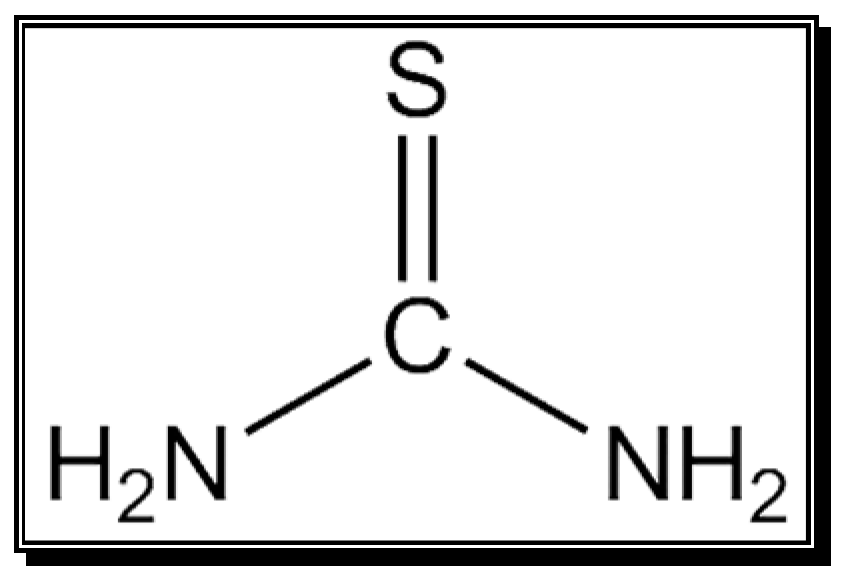
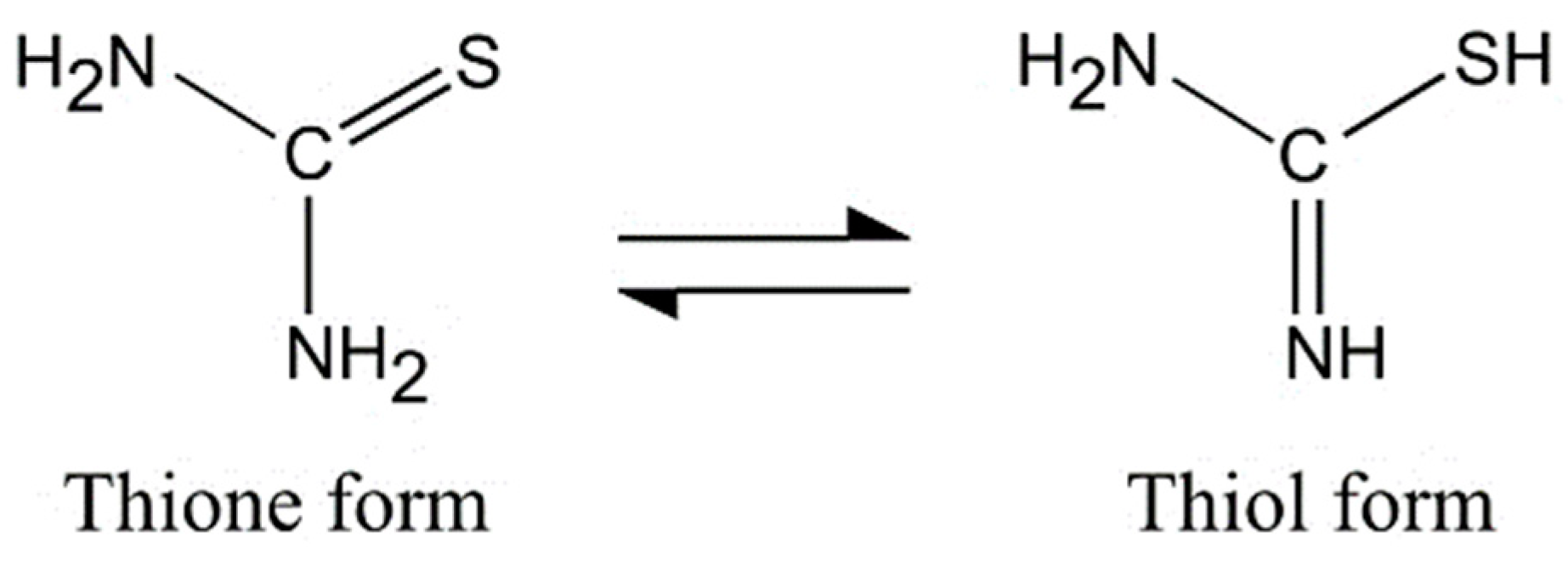
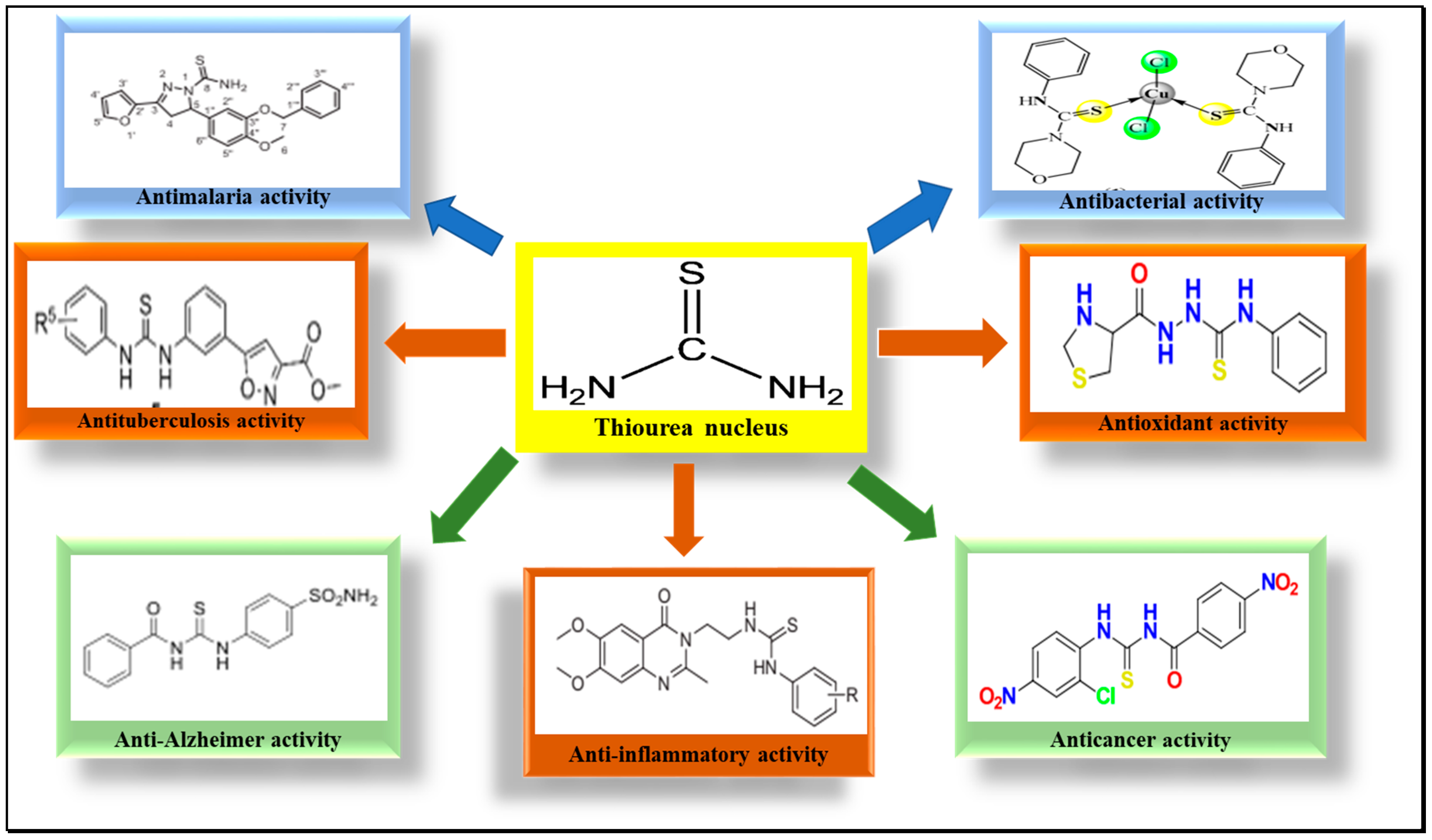

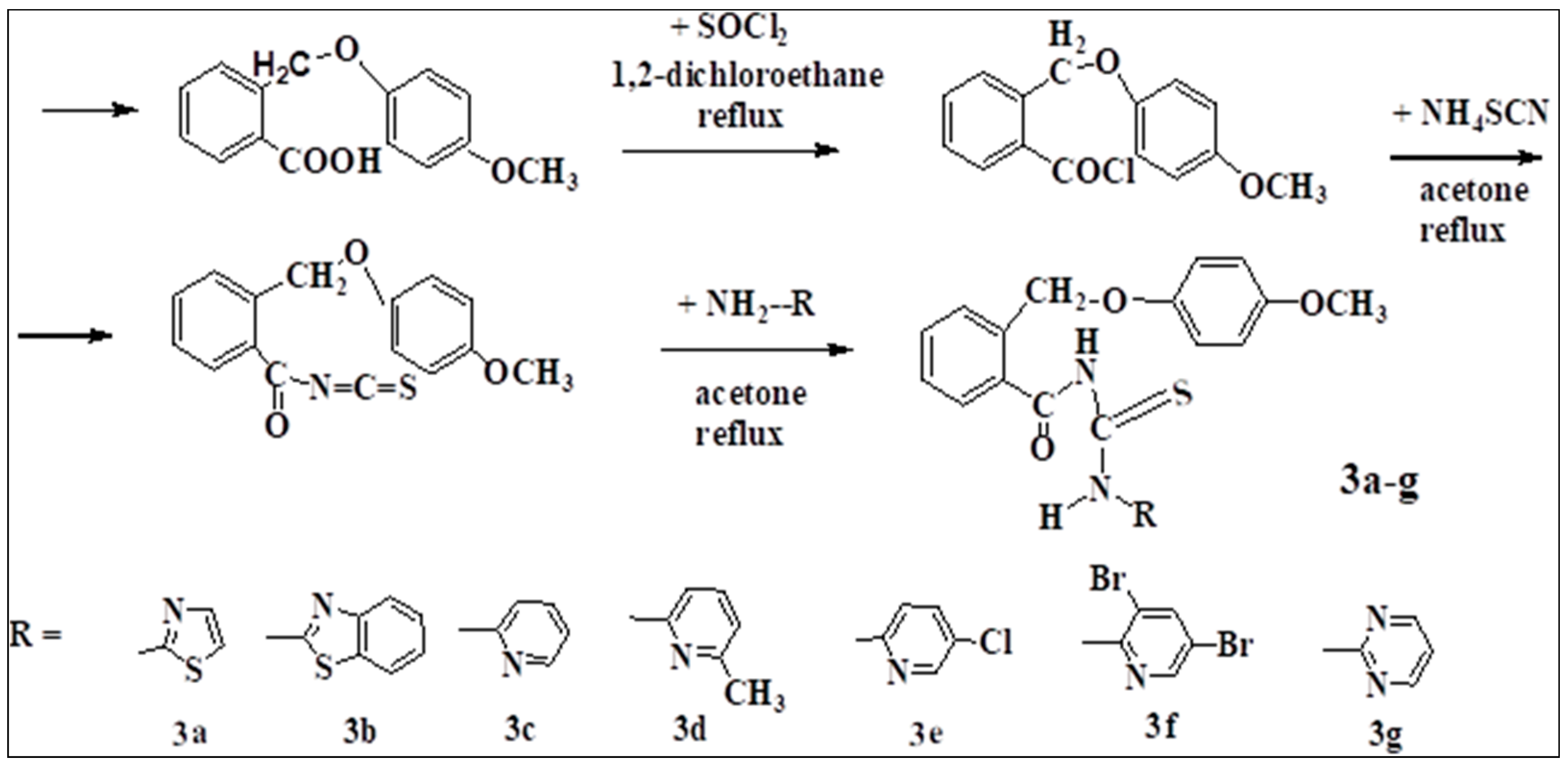
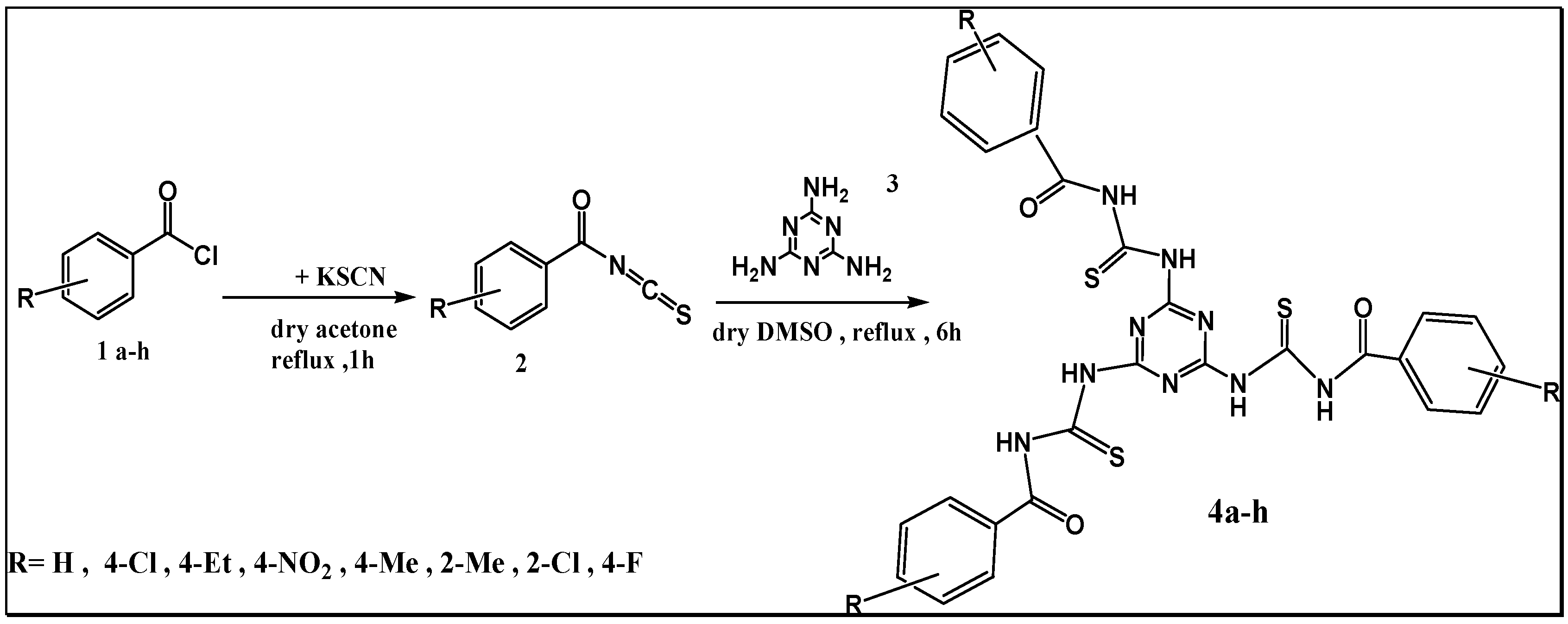

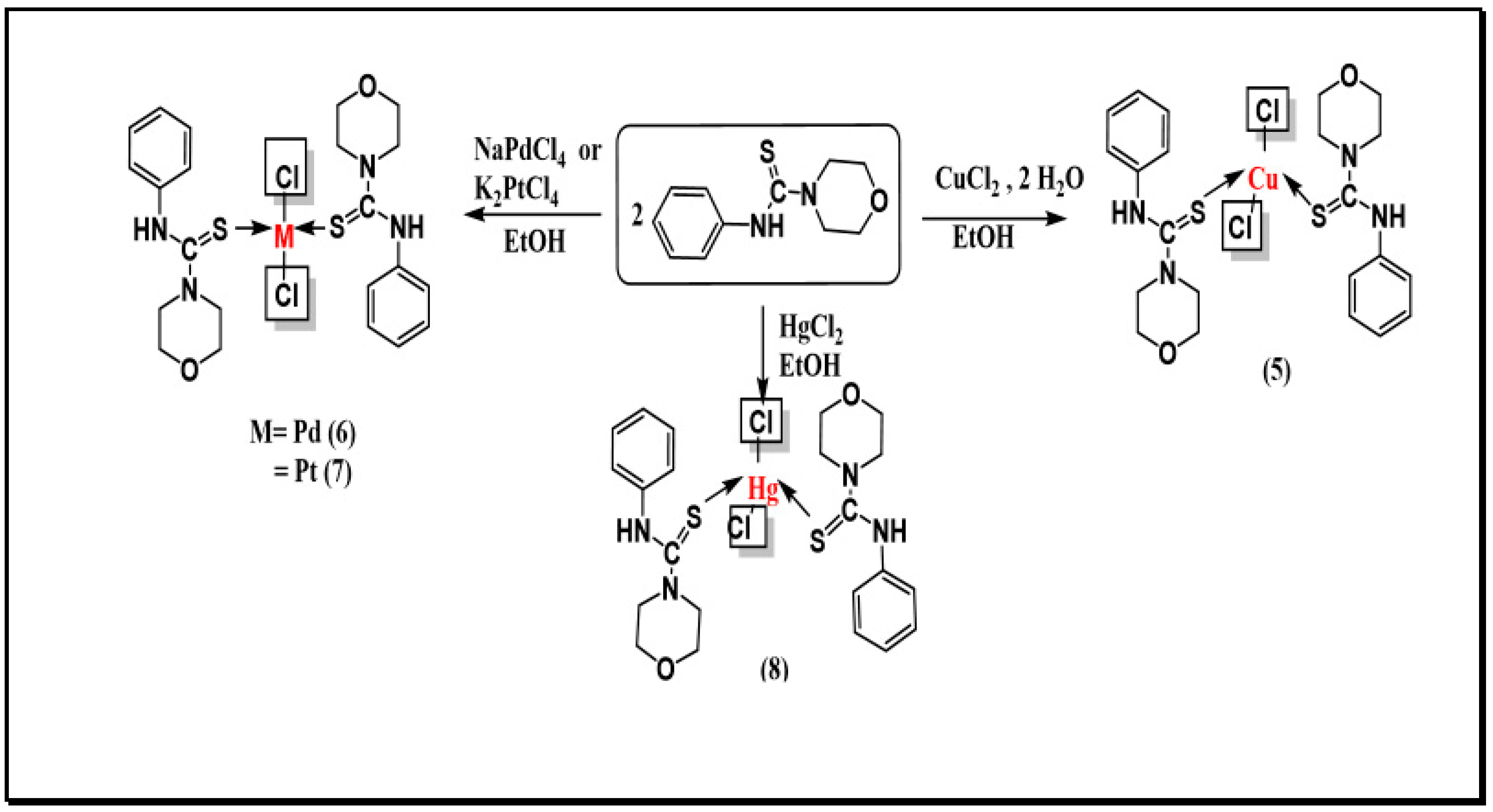
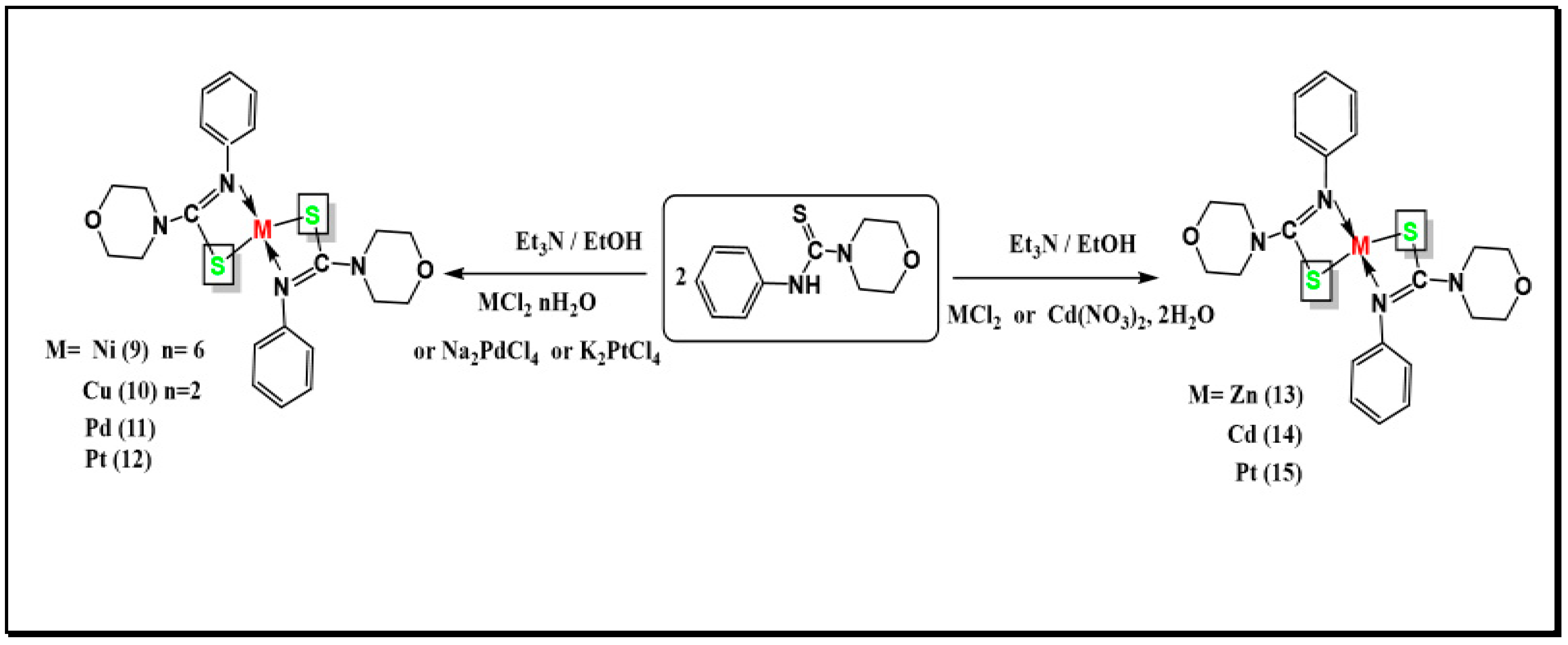
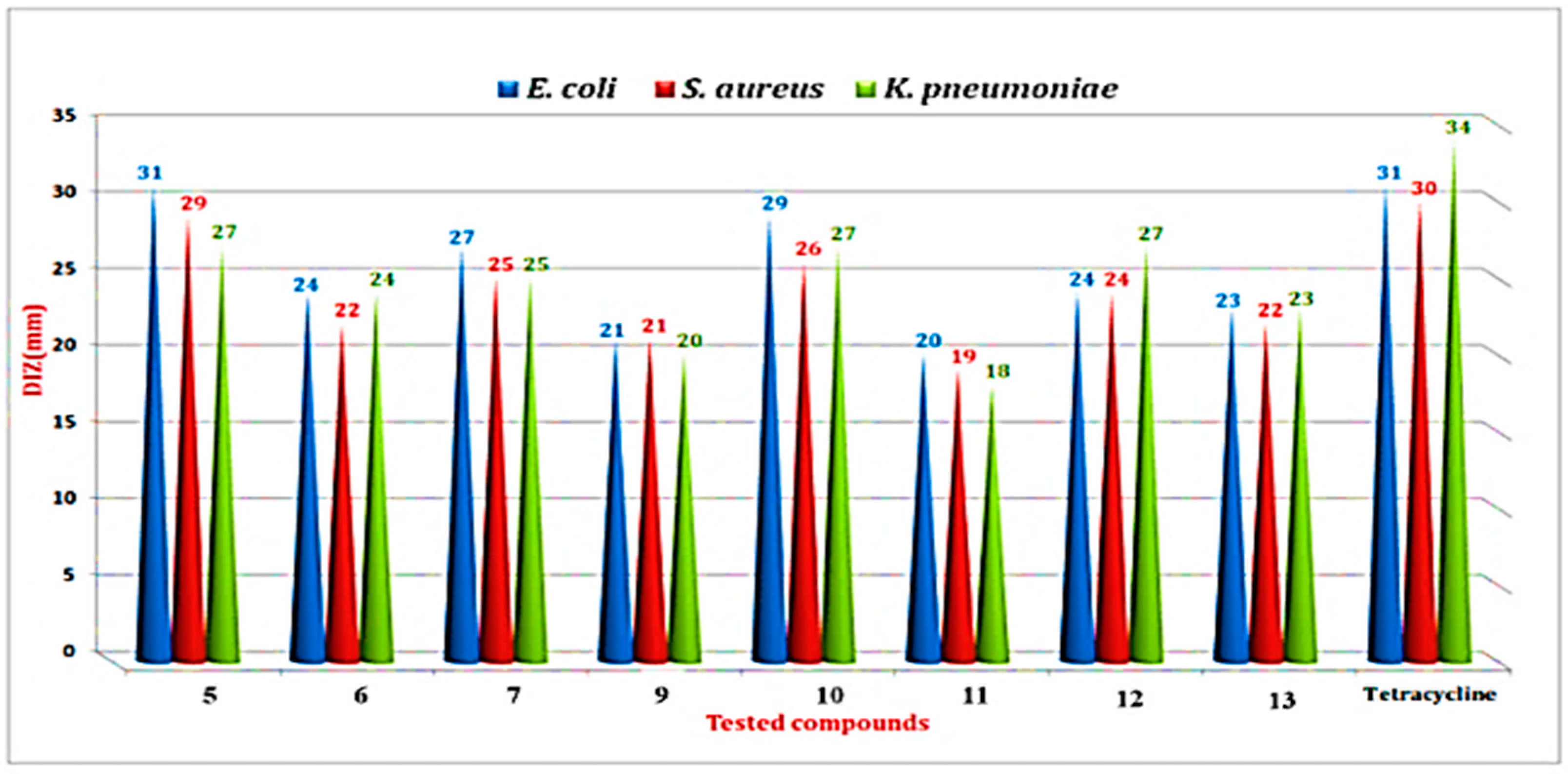
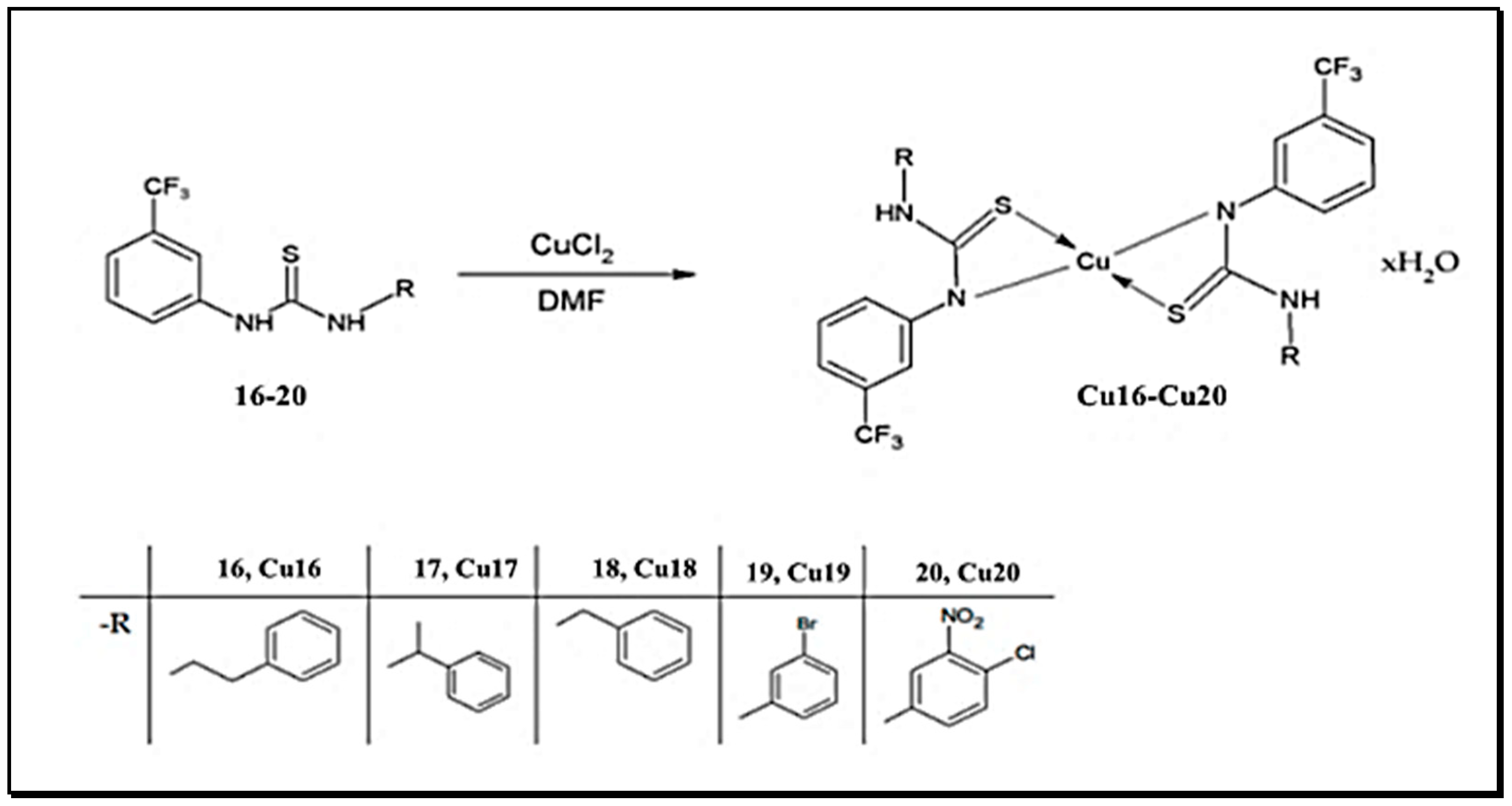
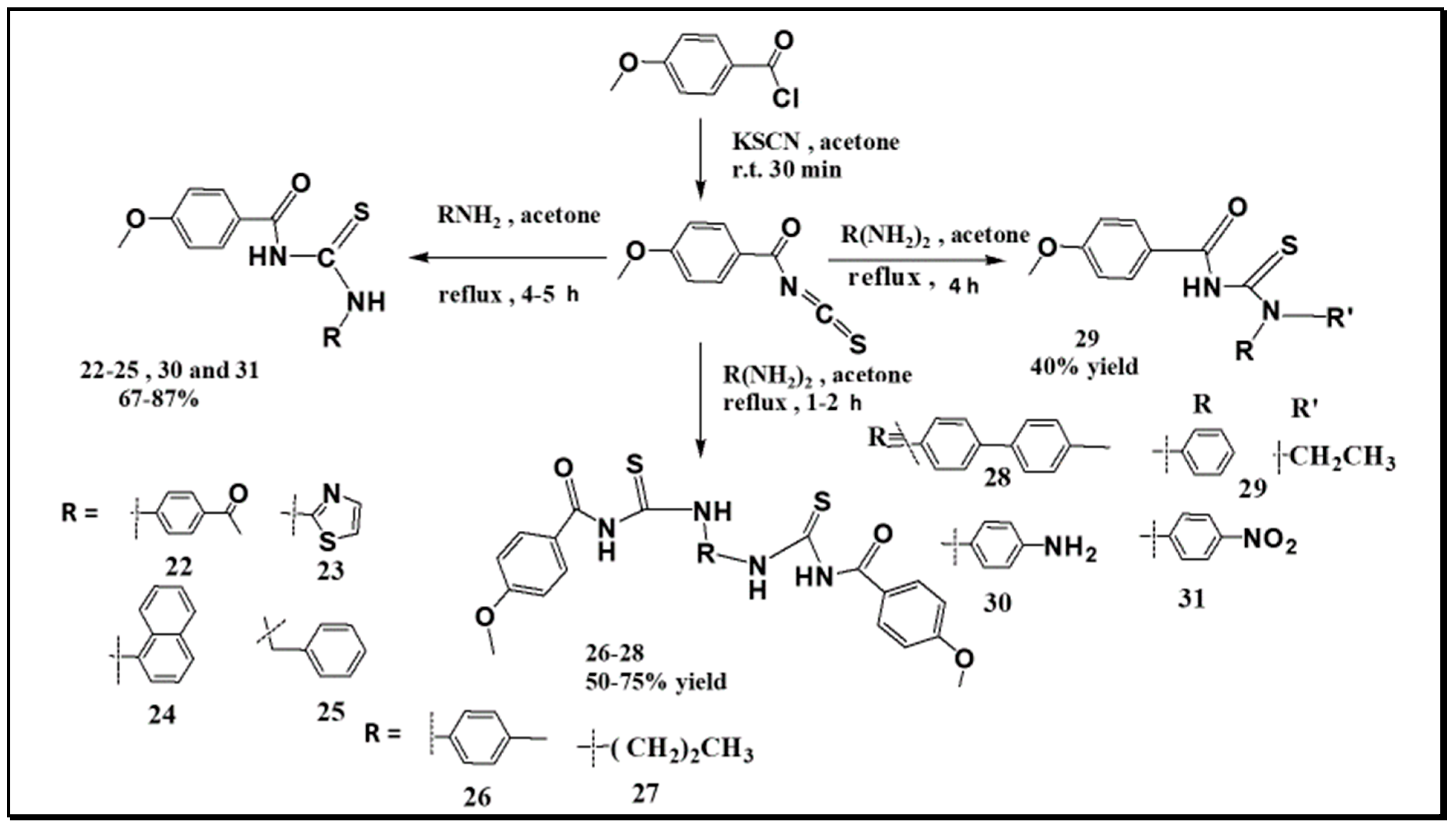
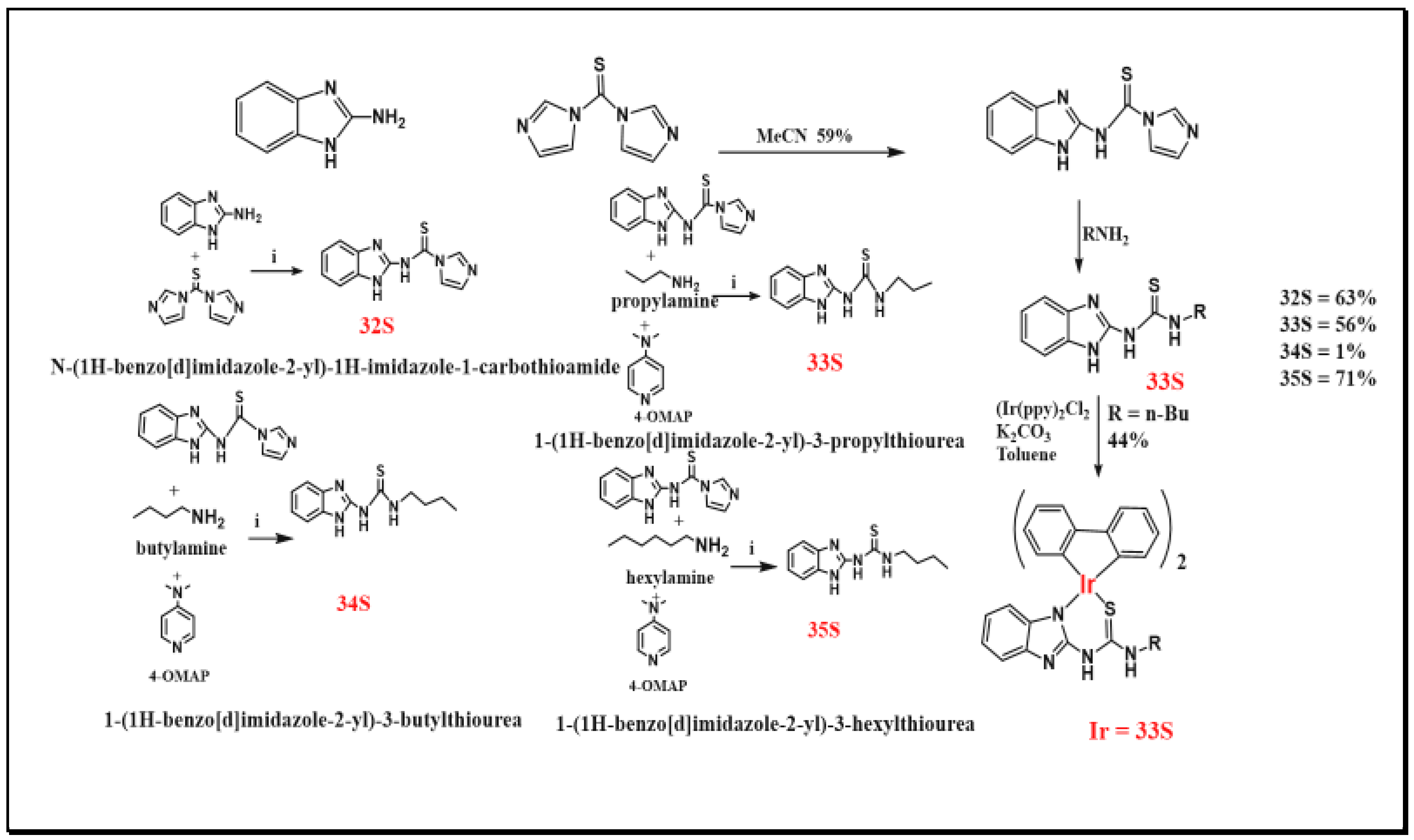


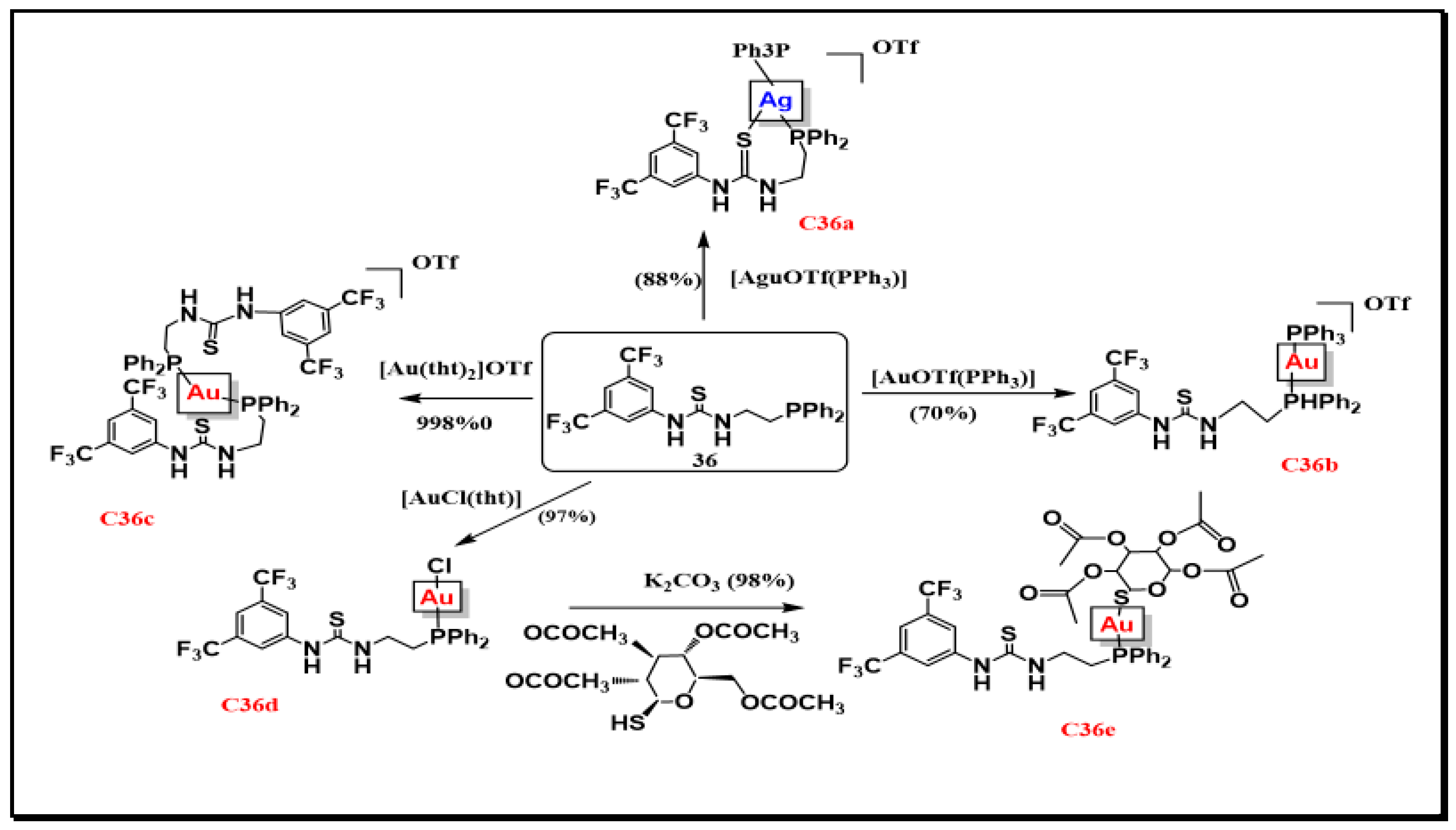
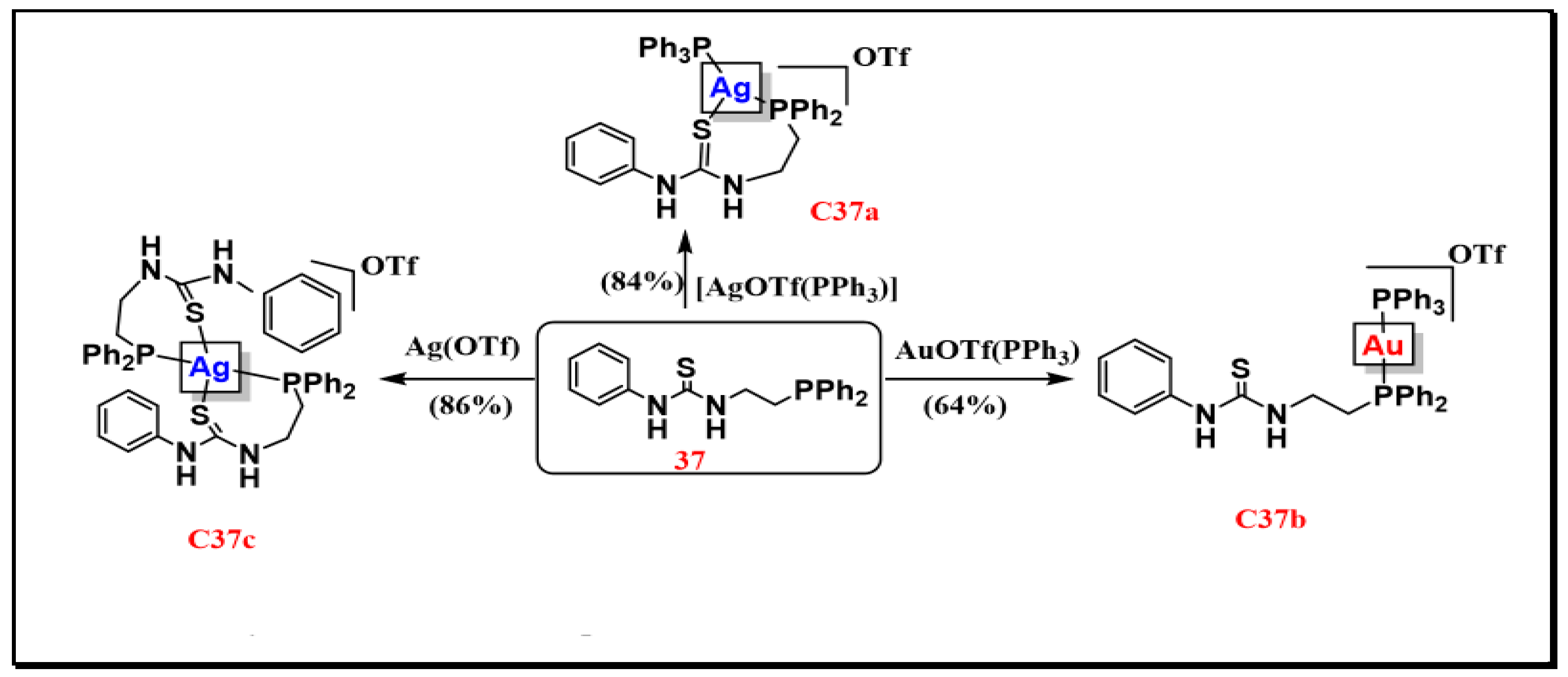
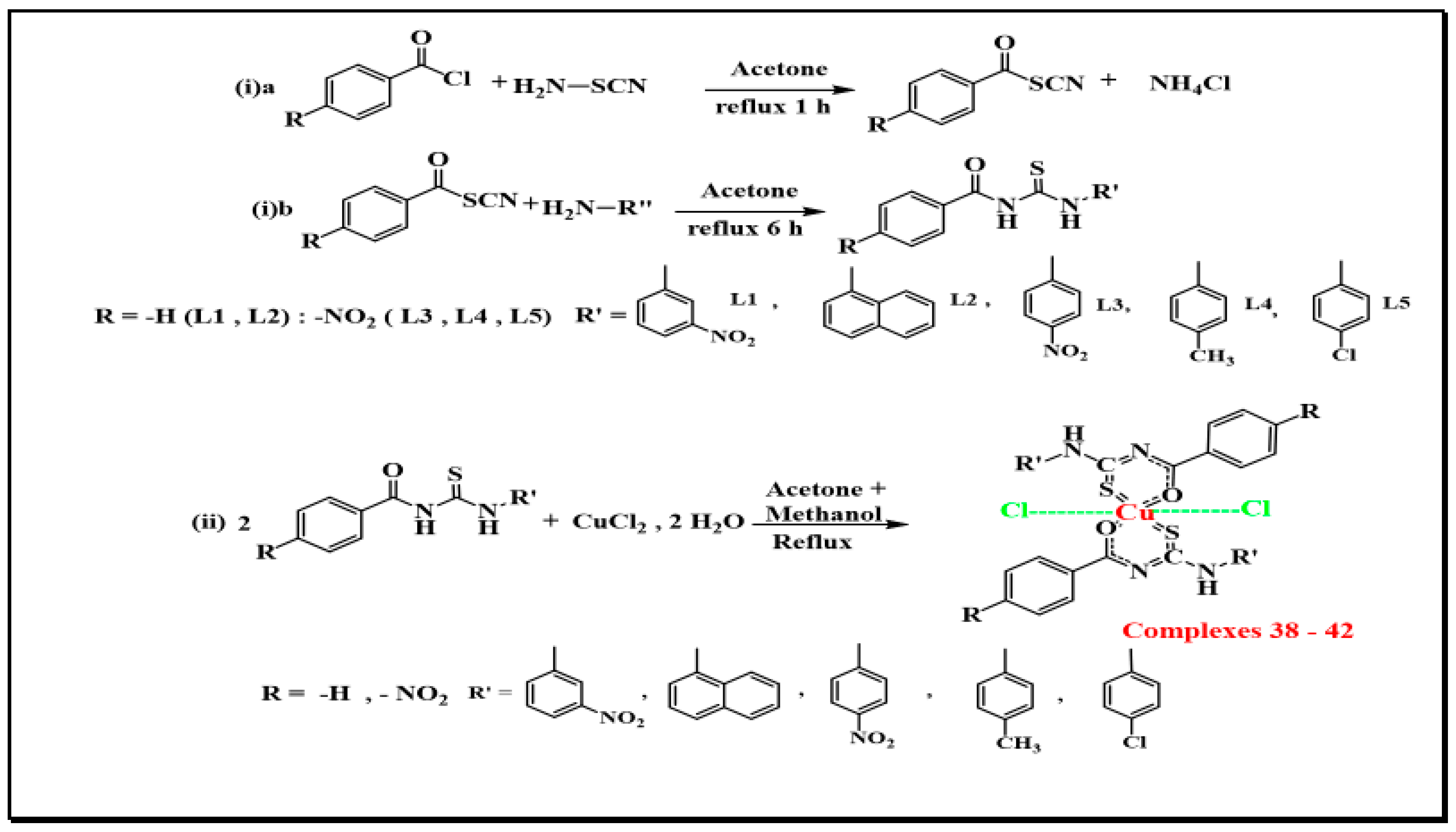
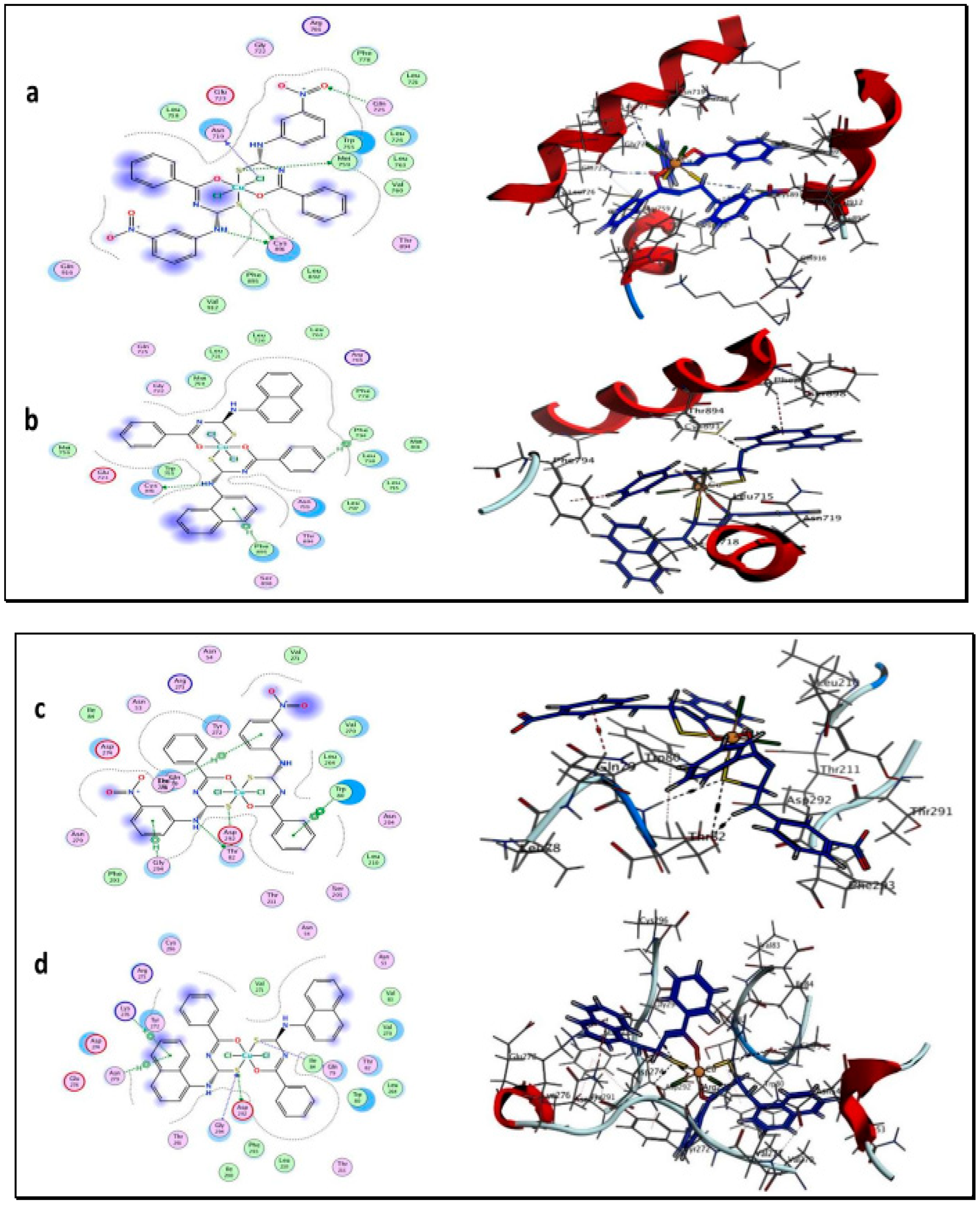



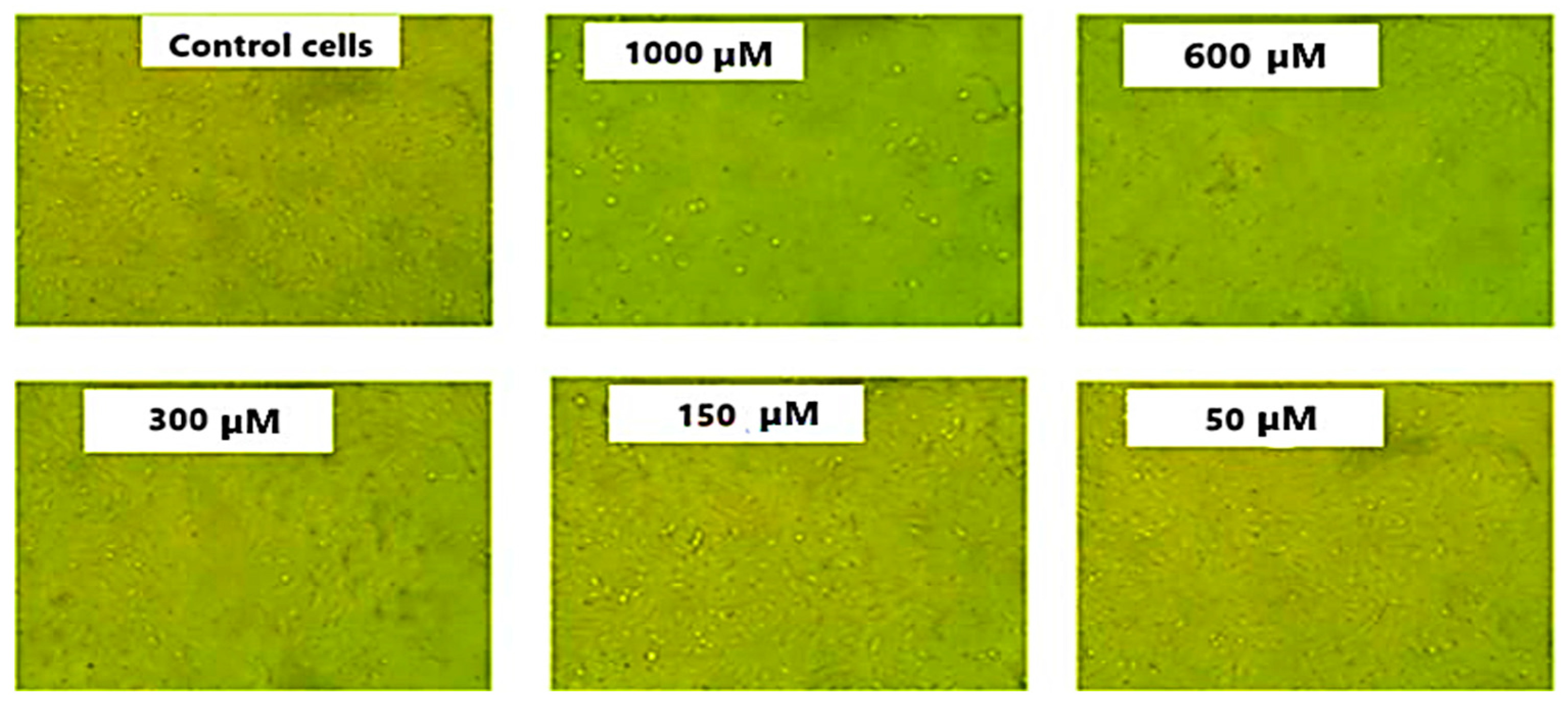
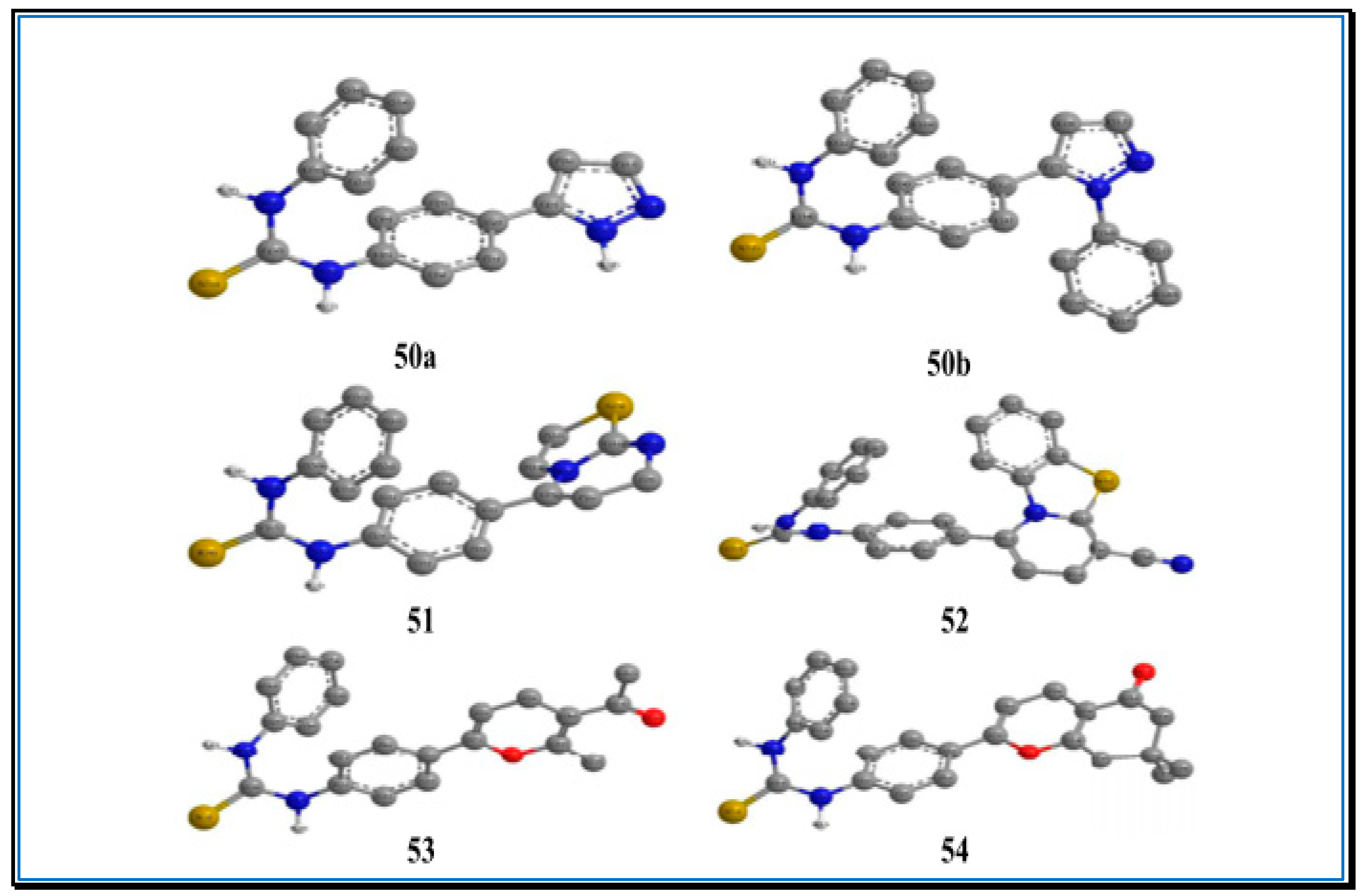

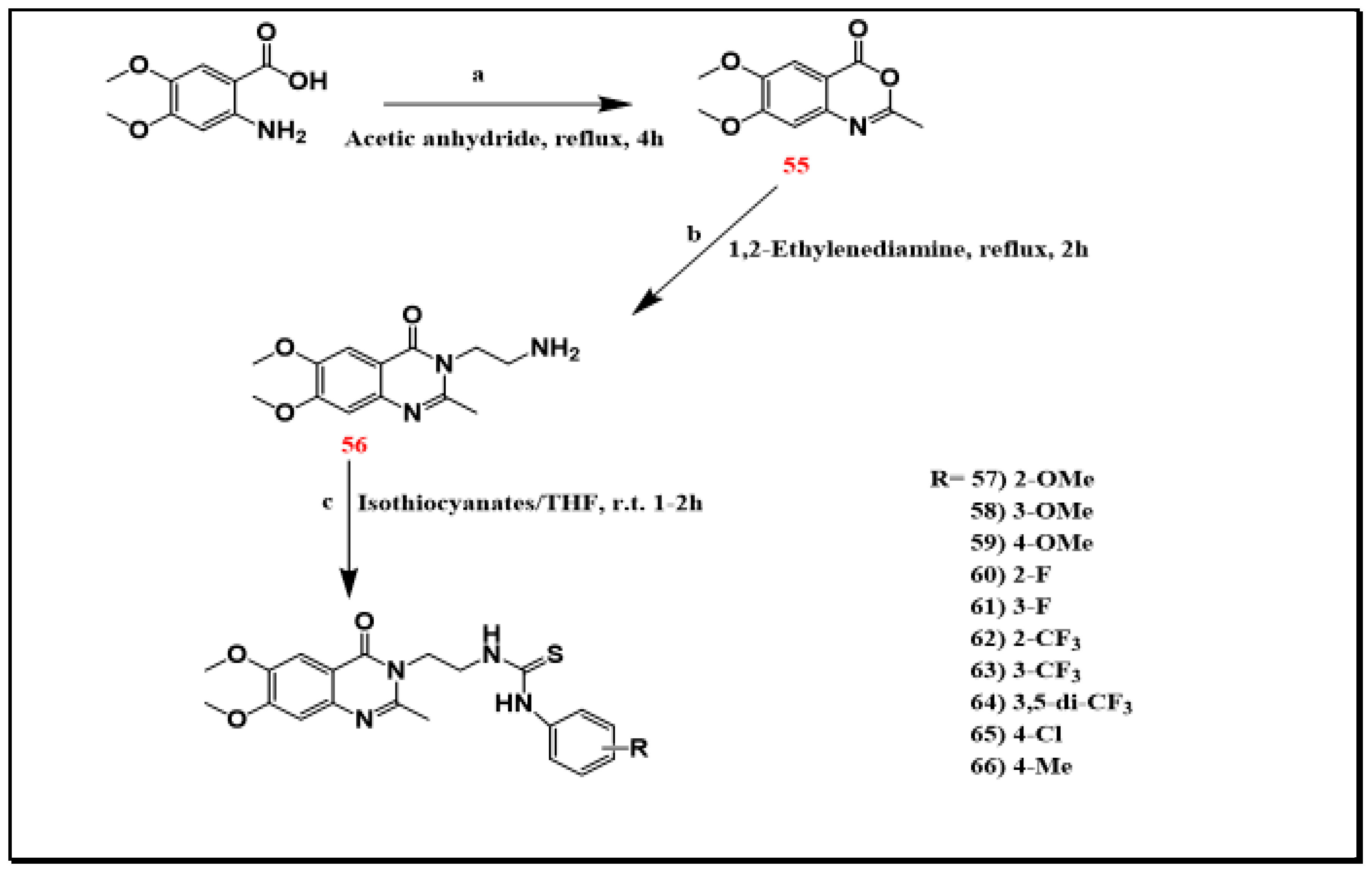
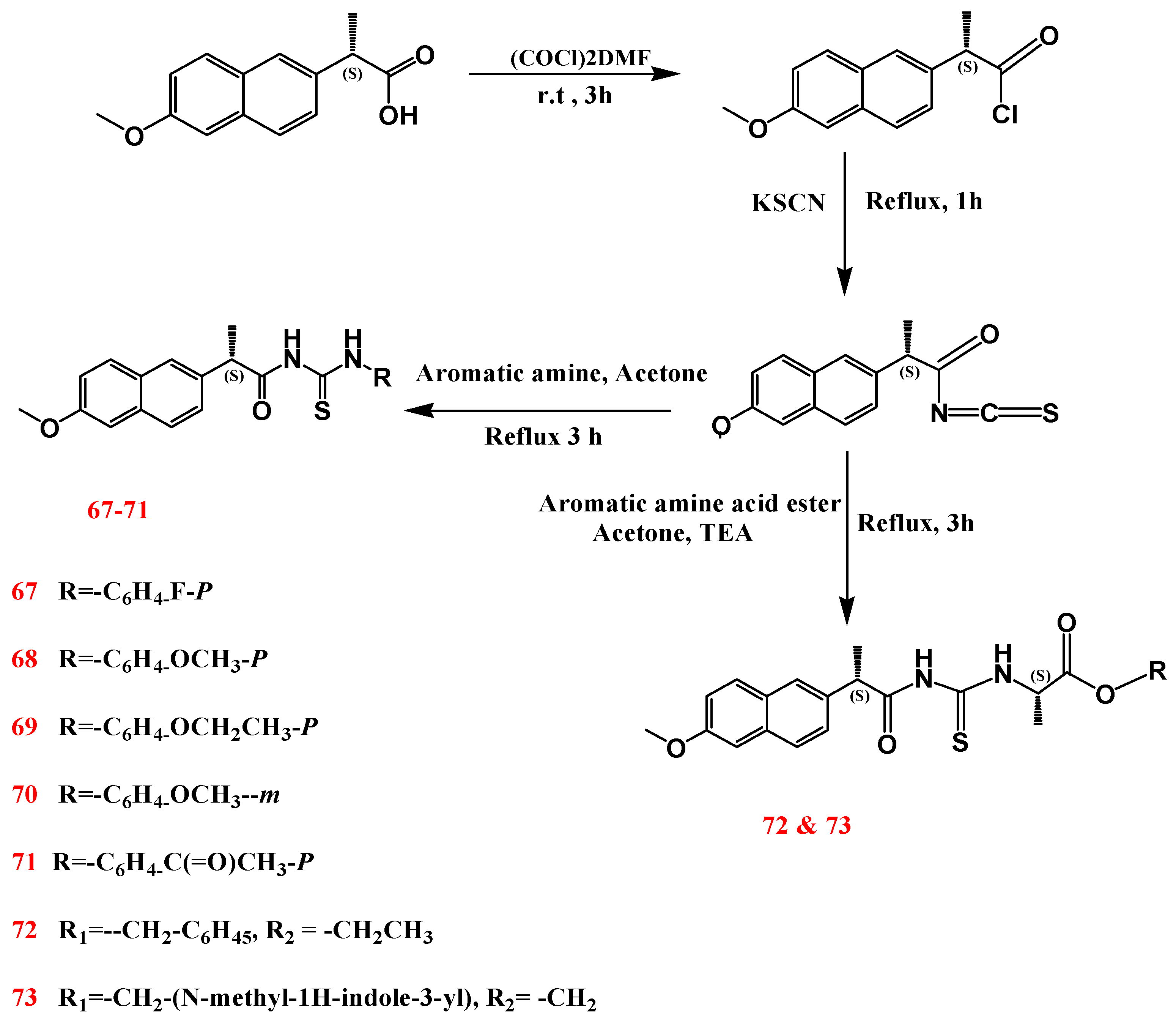
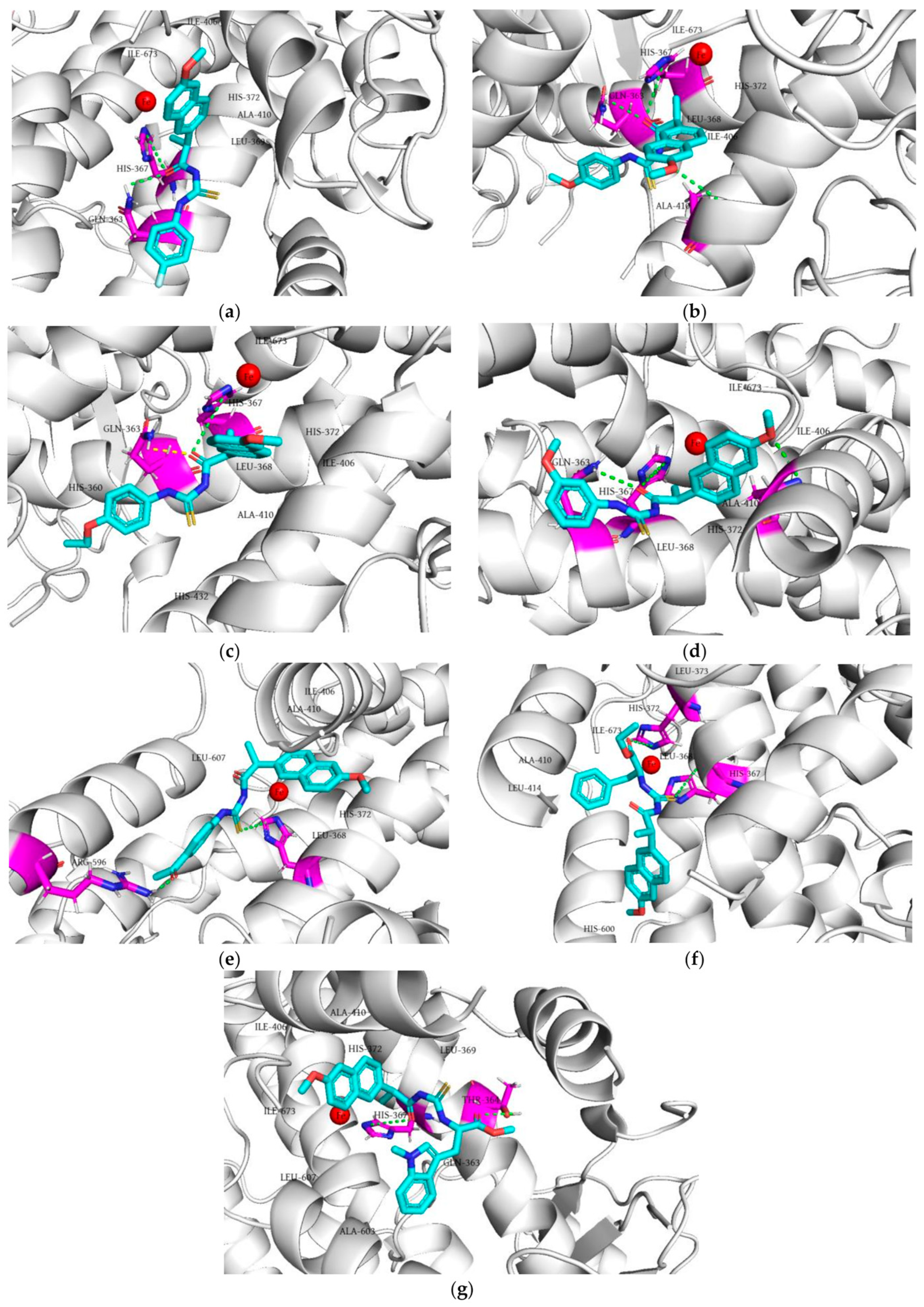
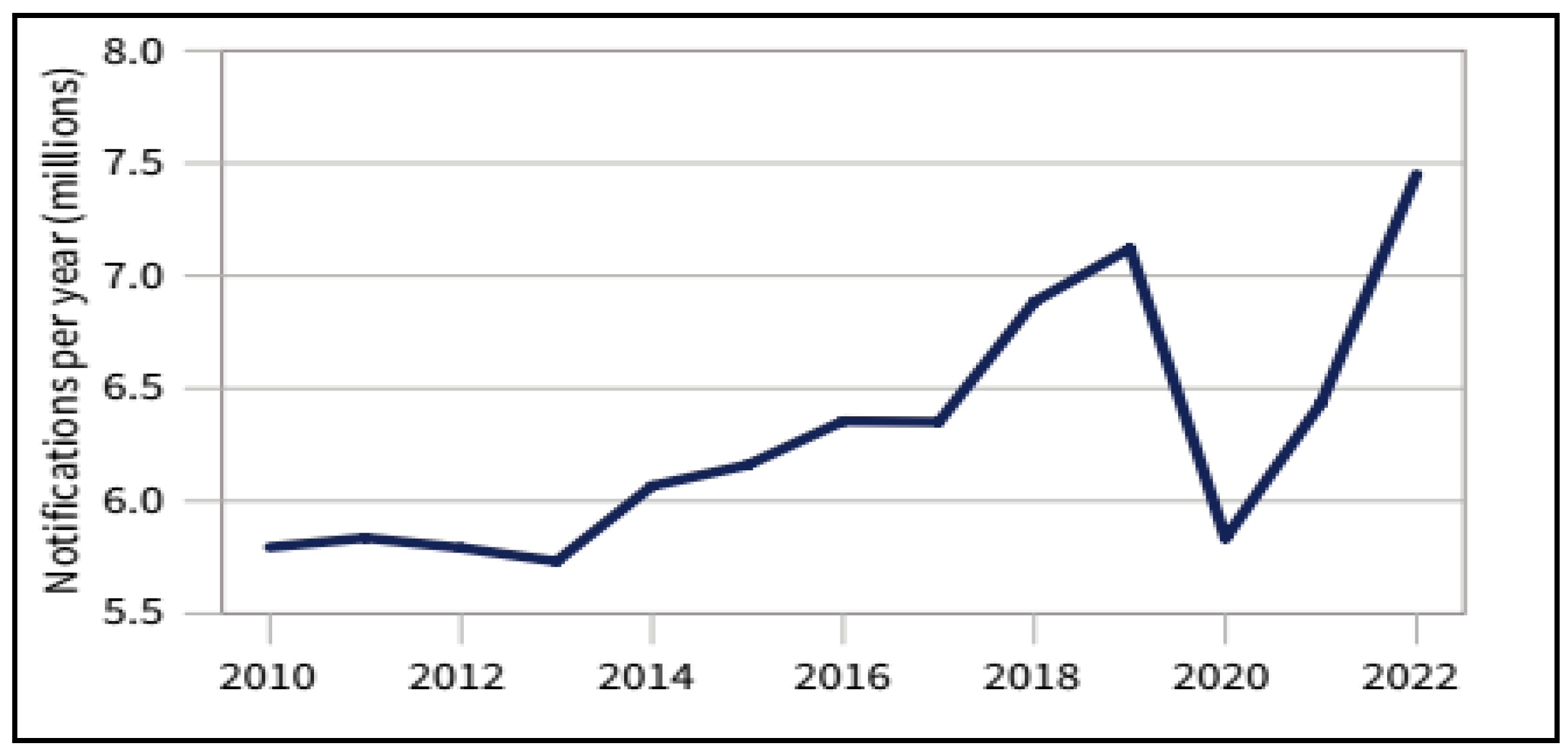
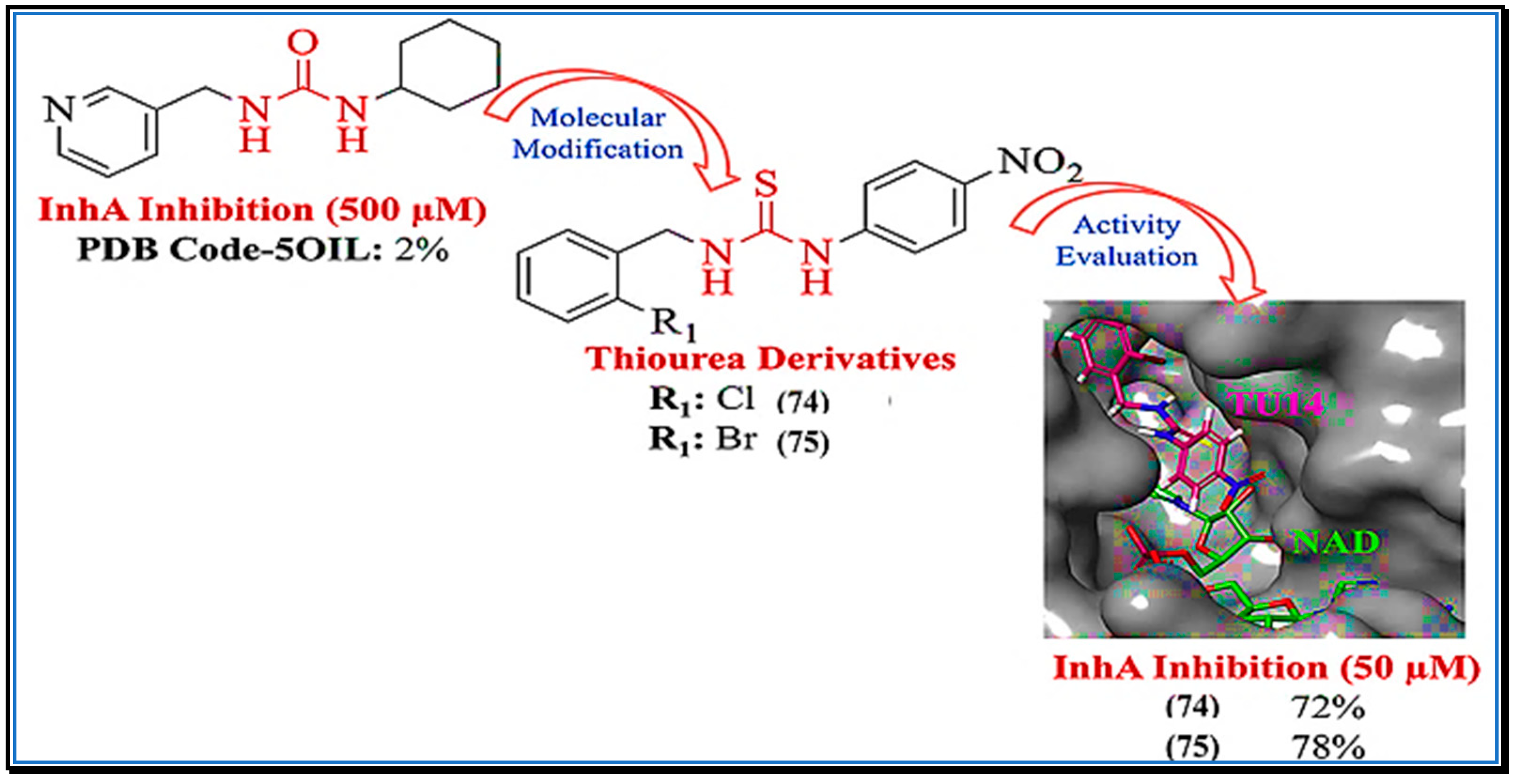
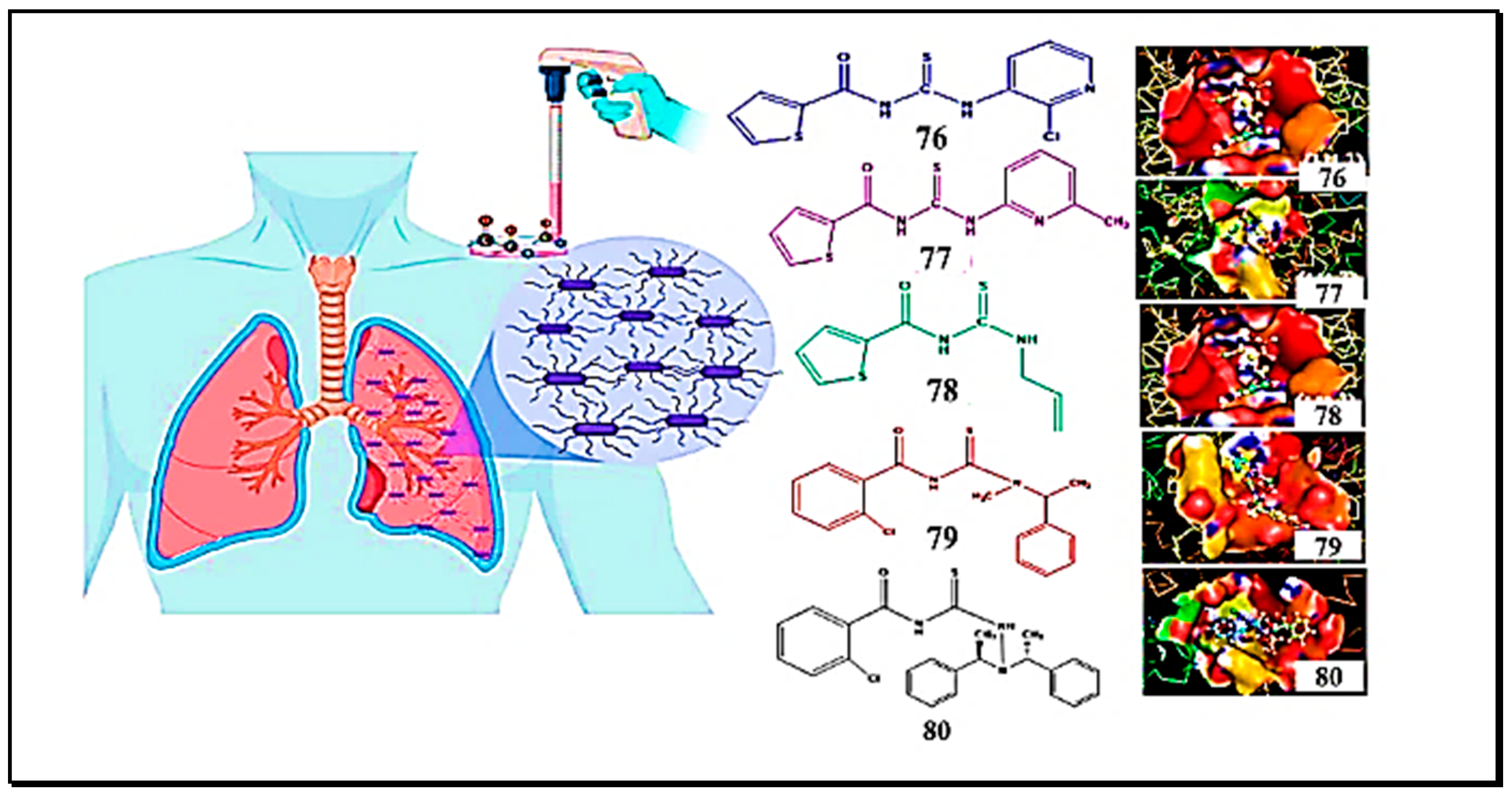
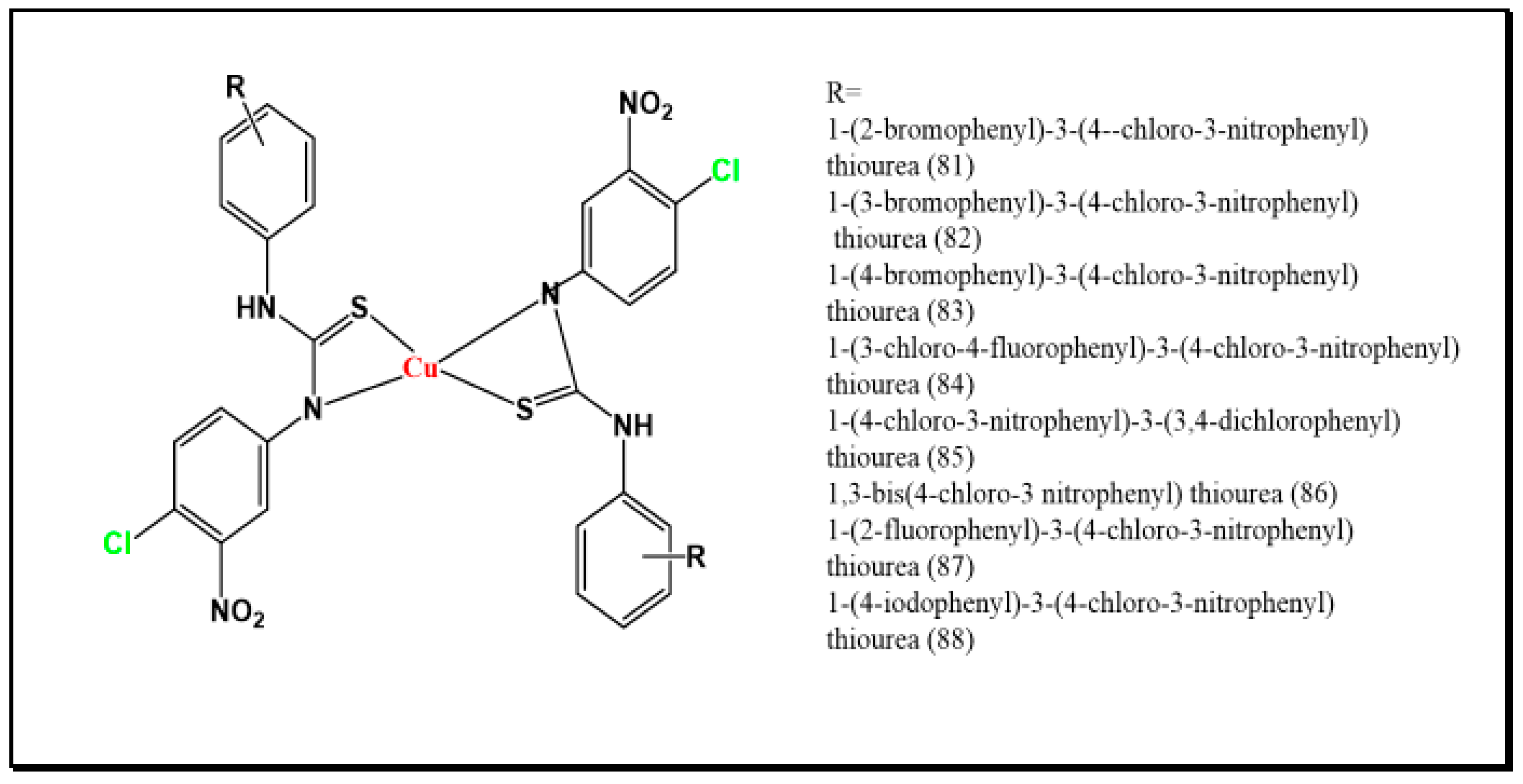
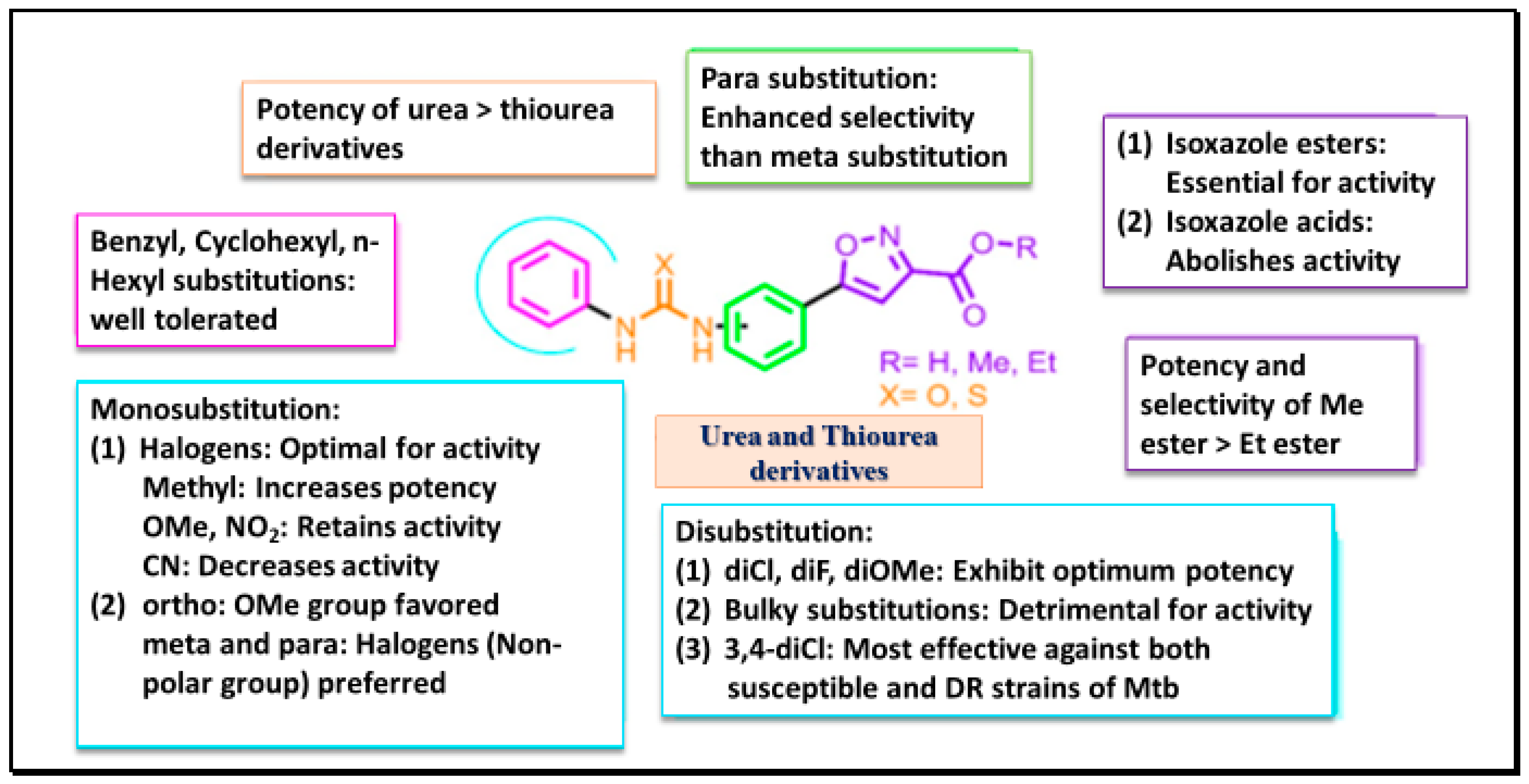
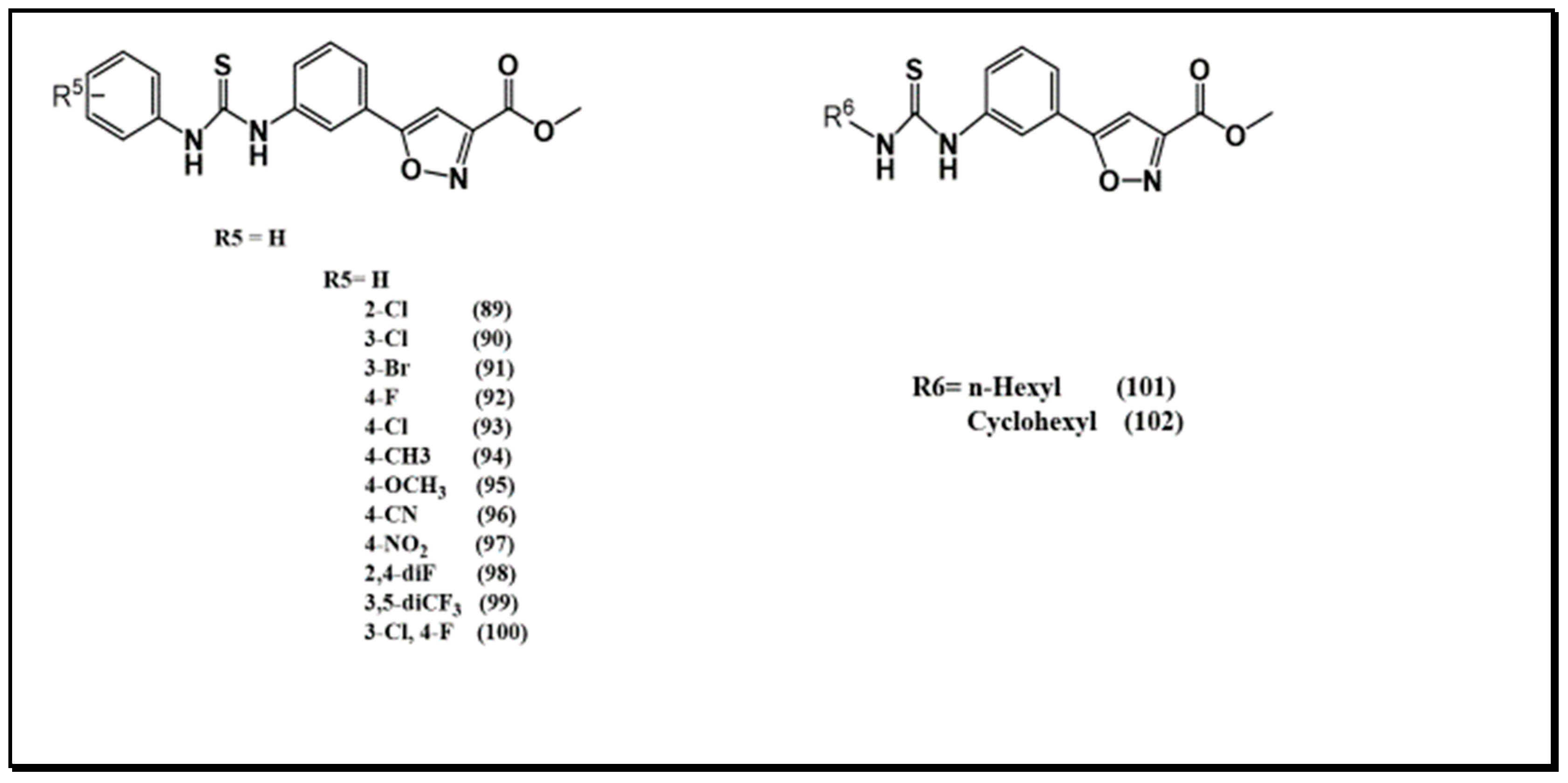
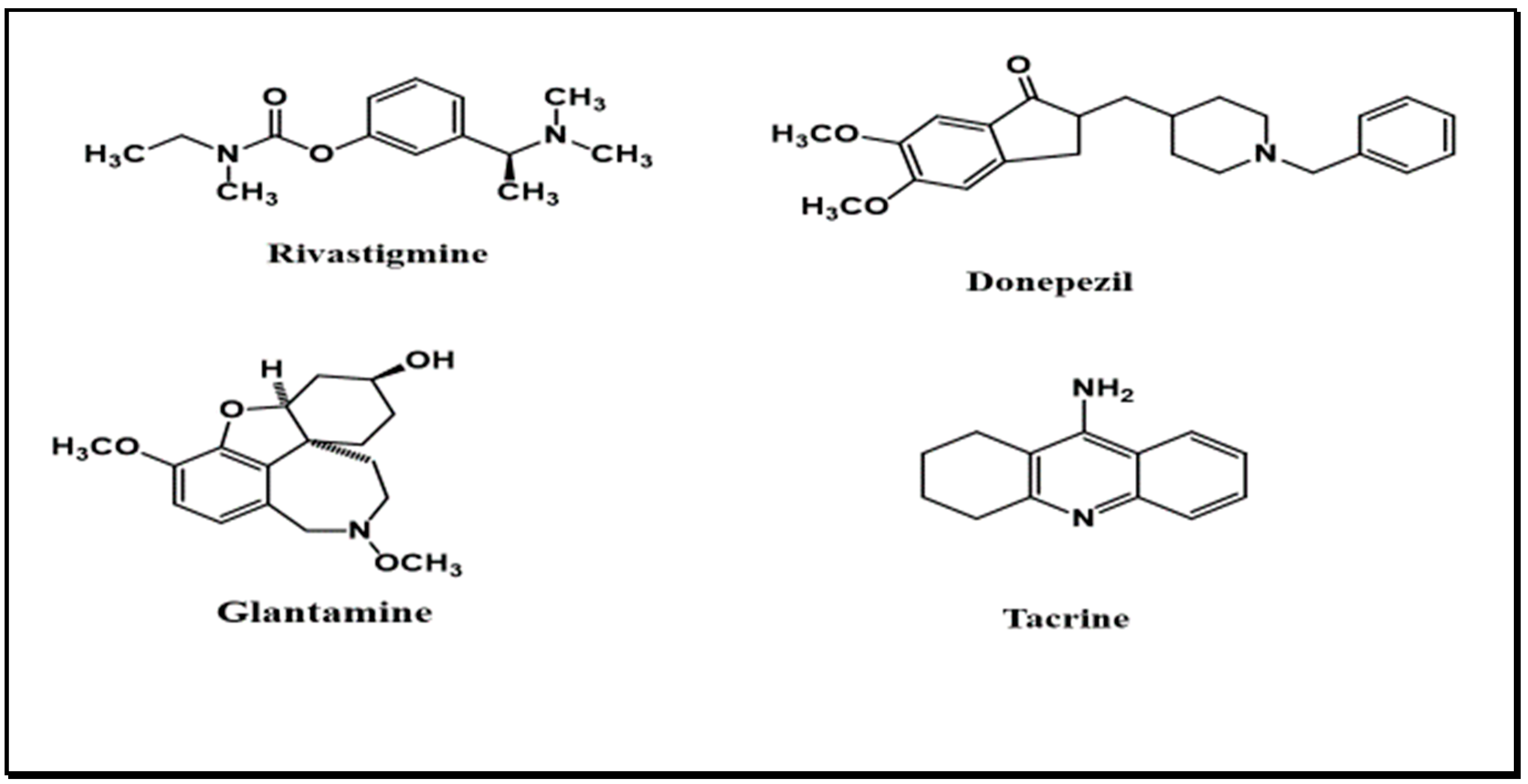
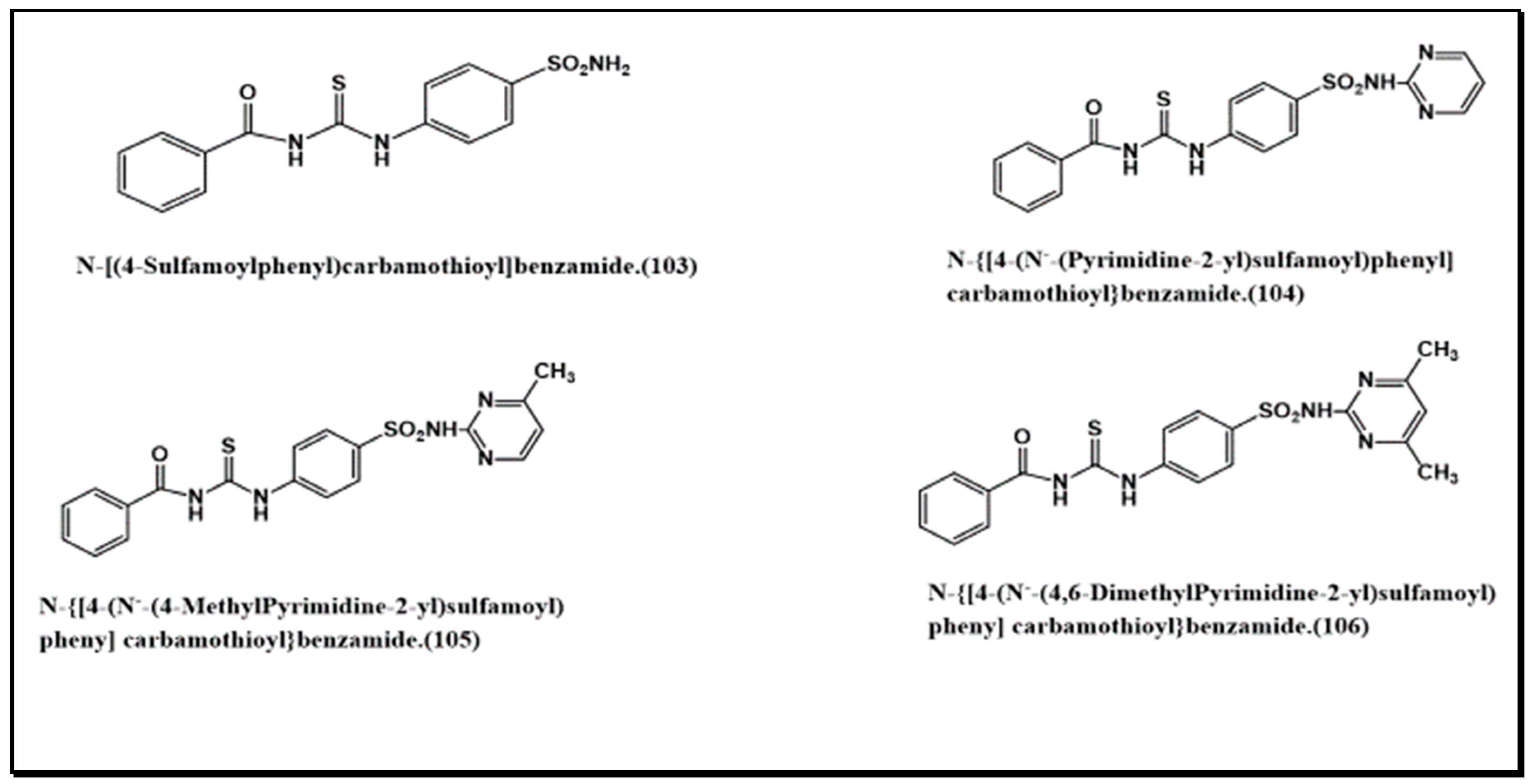

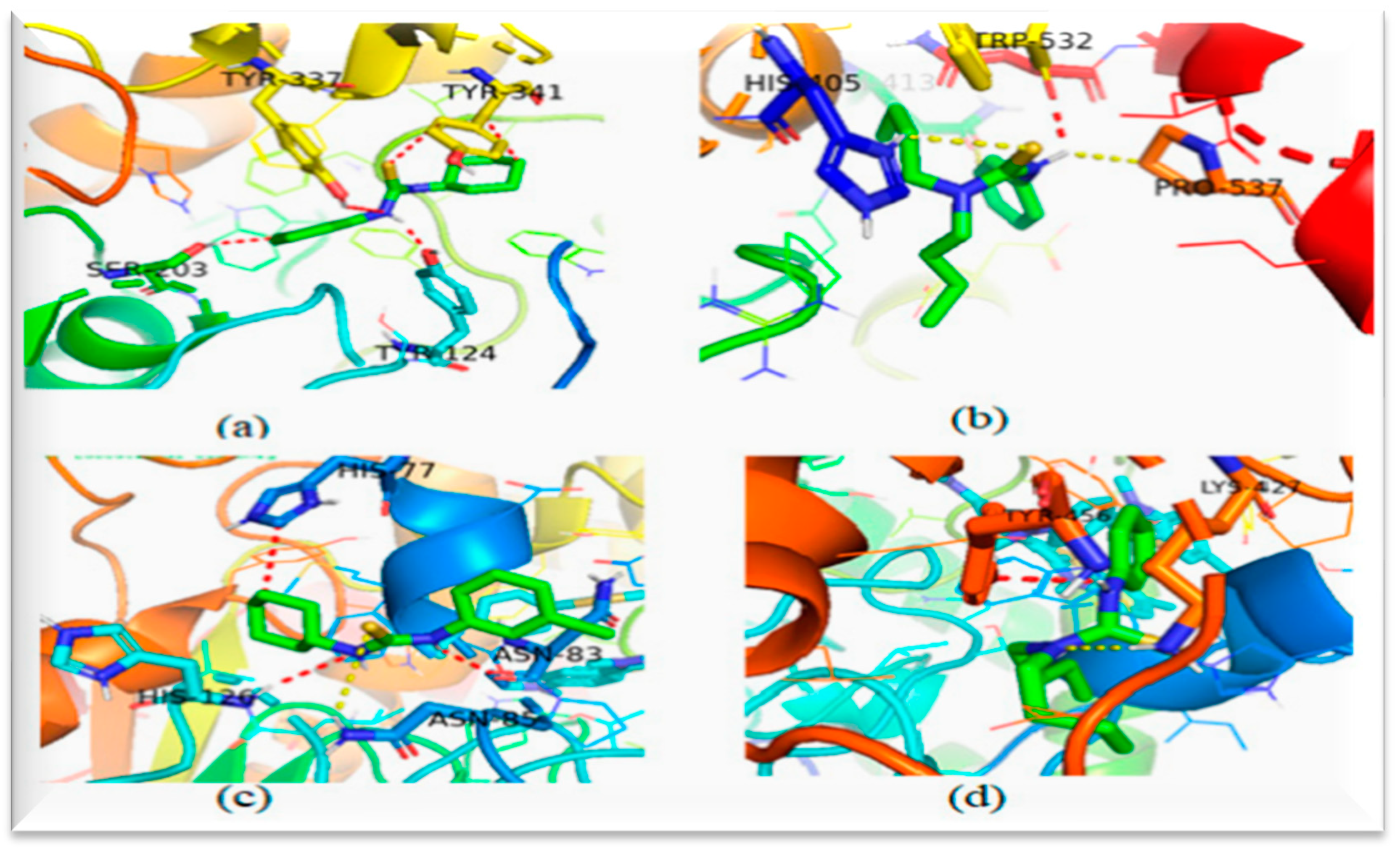

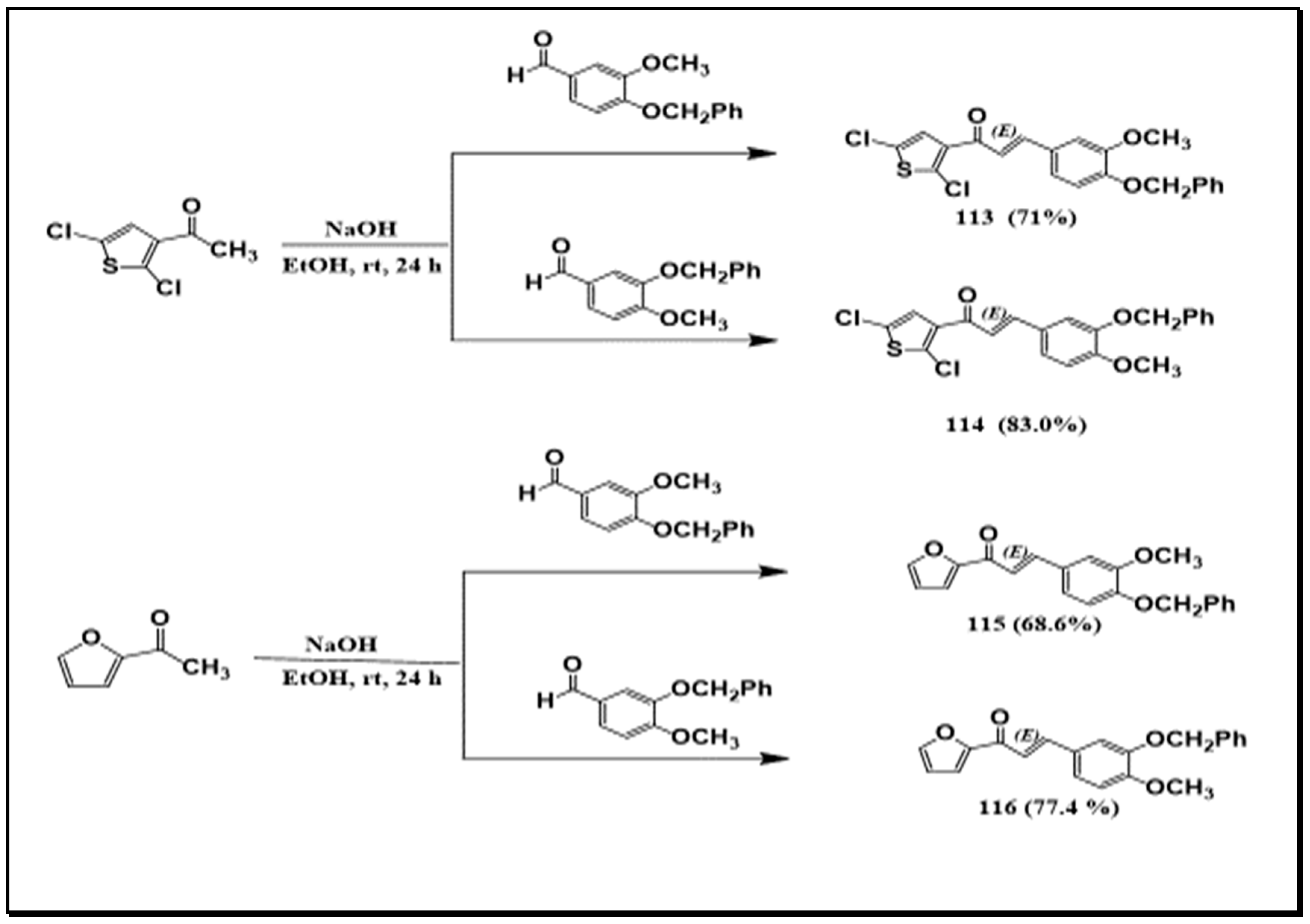
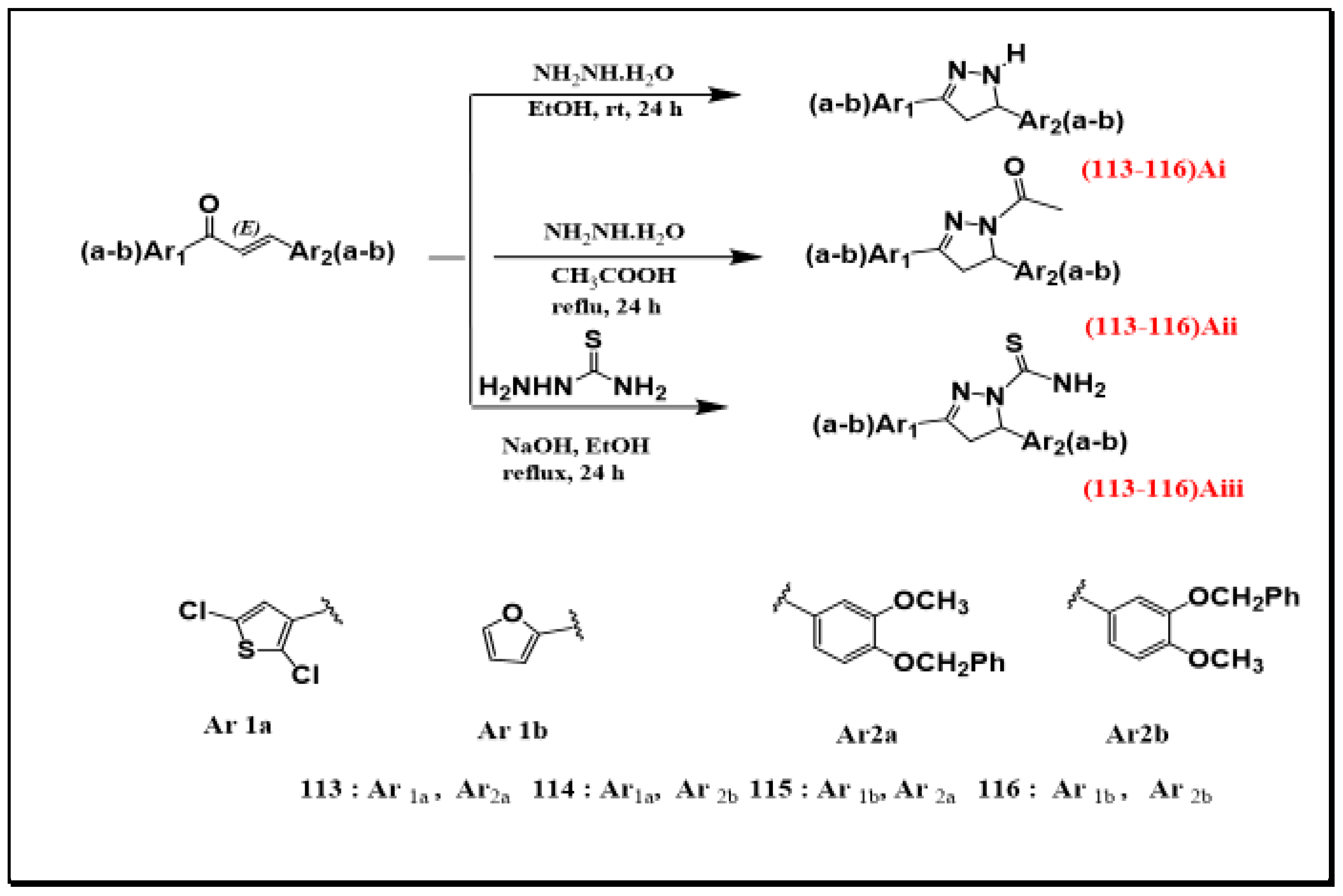
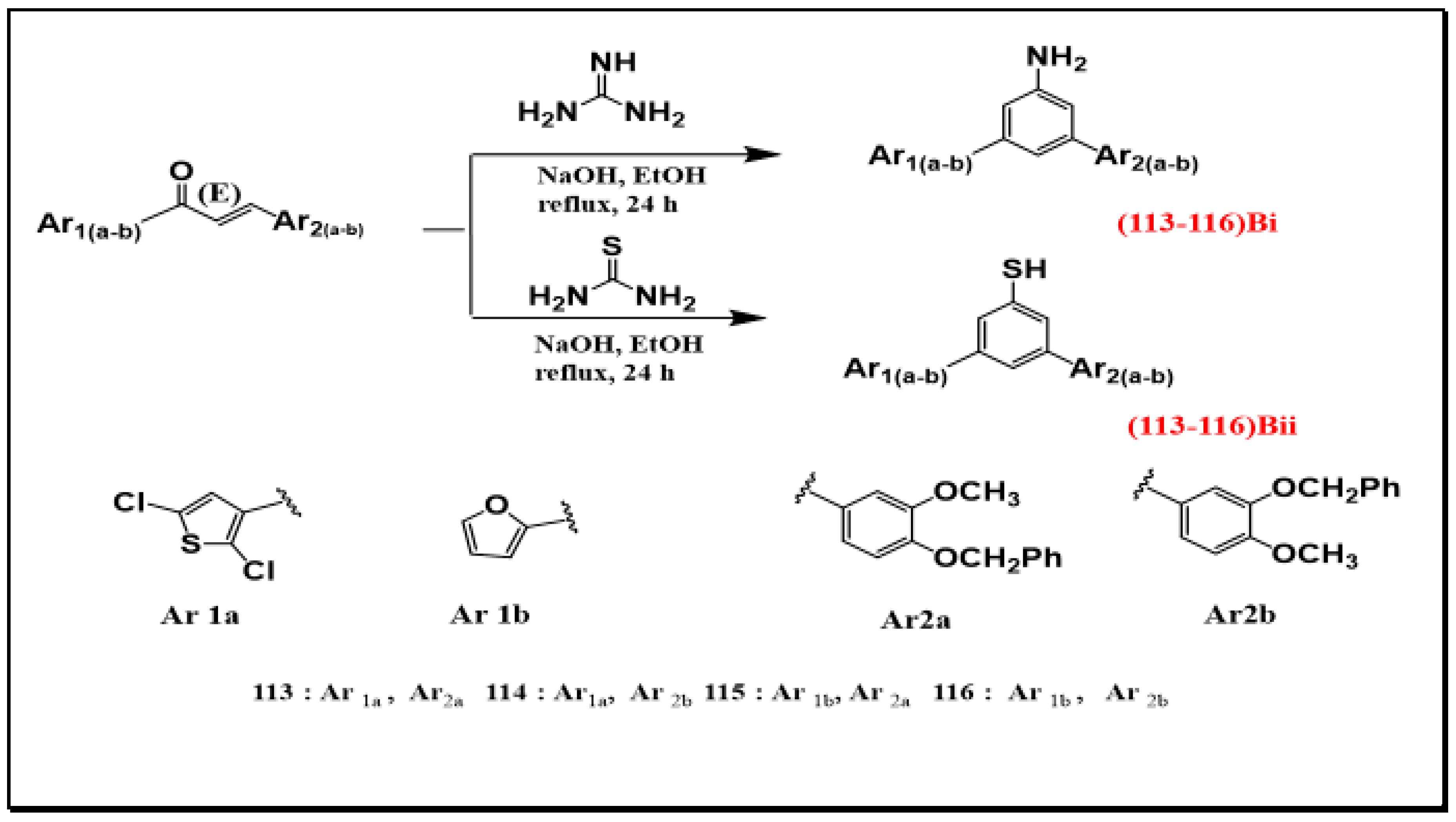

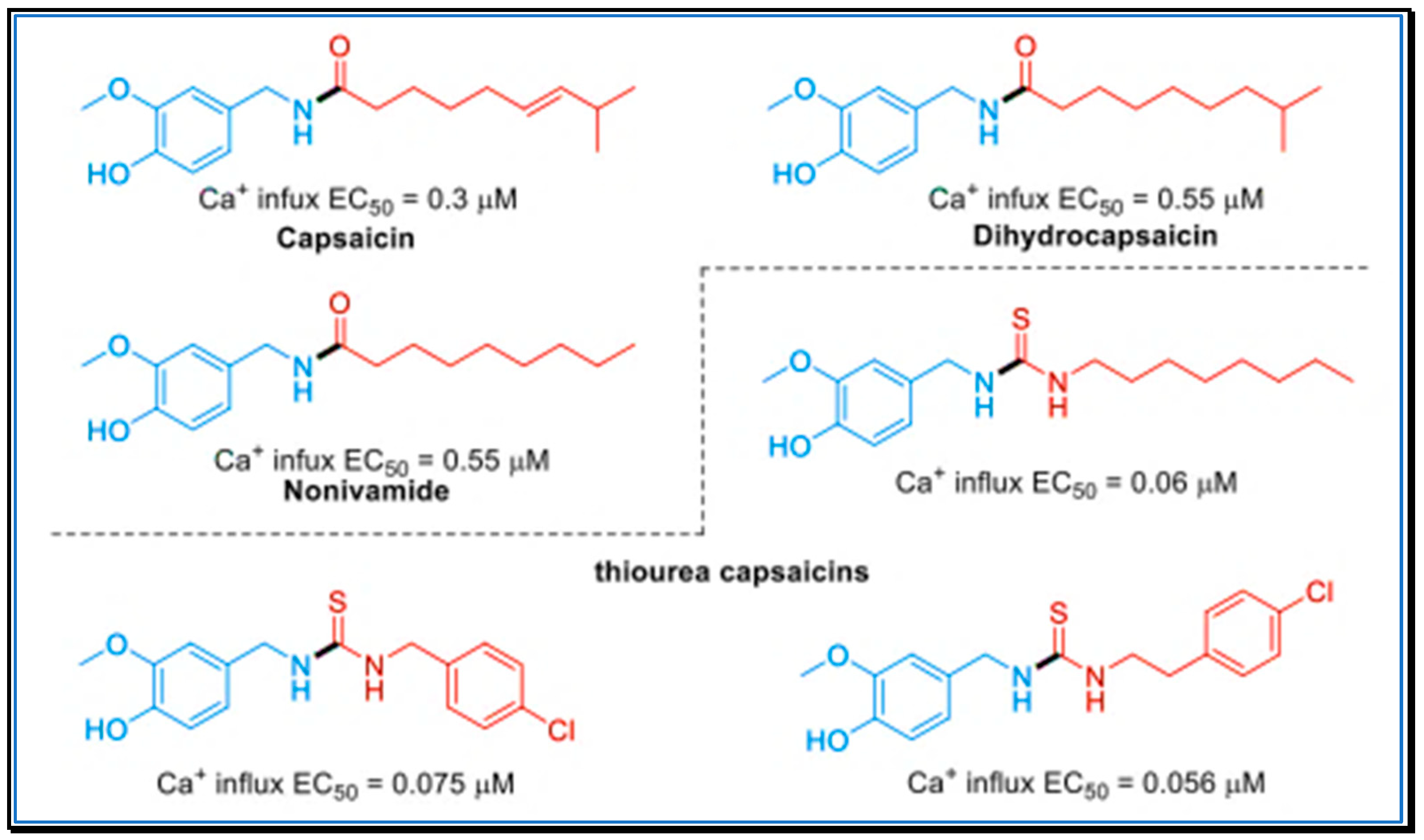
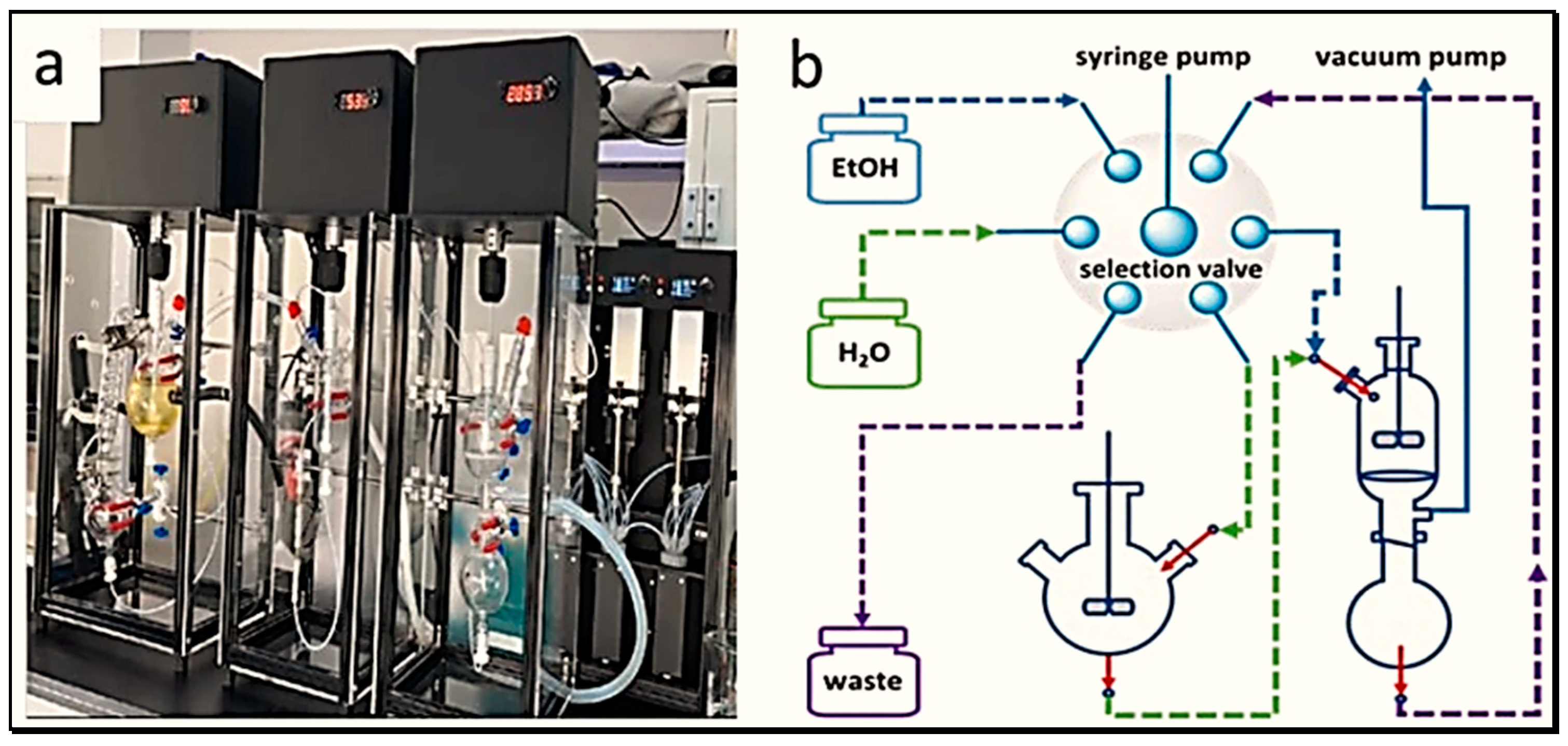
| Compound | IC50(µM) Values for Cell Lines a | ||
|---|---|---|---|
| Hela | A549 | Jurkat | |
| 36 | >25 | 13.89 ± 4.0 | >25 |
| [36-Ag-PPh3]OTf (C36a) | 10.17 ± 1.74 | 7.06 ± 1.95 | 3.89 ± 0.19 |
| [36-Au-PPh3]OTf (C36c) | 2.09 ± 0.17 | >25 | 0.62 ± 0.03 |
| [36-Au-36]OTf (C36b) | 0.25 ± 0.12 | >25 | 0.70 ± 0.06 |
| [36-Au-Cl]OTf (C36d) | >25 | >25 | 19.80 ± 0.46 |
| [36-Au-SR]OTf (C36e) | 4.52 ± 0.23 | 5.98 ± 1.18 | 2.57 ± 0.15 |
| Cisplatin | 55 ±9 b | 114.2 ± 9.1 c | 10.8 ±1.2 c |
| Compound | IC50(µM) Values for Cell Lines a | ||
|---|---|---|---|
| Hela | A549 | Jurkat | |
| 37 | 8.16 ± 0.15 | >25 | 14.20 ± 0.72 |
| [37-Ag-PPh3]OTf (C37a) | 0.87 ± 0.06 | 0.79 ± 0.04 | 0.64 ± 0.04 |
| [37-Au-PPh3]OTf (C37b) | 1.48 ± 0.15 | 4.91 ± 0.23 | 5.15 ± 0.32 |
| [37-Ag-37]OTf (C37c) | 1.52 ± 0.09 | 0.58 ± 0.02 | 1.53 ± 0.31 |
Disclaimer/Publisher’s Note: The statements, opinions and data contained in all publications are solely those of the individual author(s) and contributor(s) and not of MDPI and/or the editor(s). MDPI and/or the editor(s) disclaim responsibility for any injury to people or property resulting from any ideas, methods, instructions or products referred to in the content. |
© 2024 by the author. Licensee MDPI, Basel, Switzerland. This article is an open access article distributed under the terms and conditions of the Creative Commons Attribution (CC BY) license (https://creativecommons.org/licenses/by/4.0/).
Share and Cite
Agili, F.A. Biological Applications of Thiourea Derivatives: Detailed Review. Chemistry 2024, 6, 435-468. https://doi.org/10.3390/chemistry6030025
Agili FA. Biological Applications of Thiourea Derivatives: Detailed Review. Chemistry. 2024; 6(3):435-468. https://doi.org/10.3390/chemistry6030025
Chicago/Turabian StyleAgili, Fatimah A. 2024. "Biological Applications of Thiourea Derivatives: Detailed Review" Chemistry 6, no. 3: 435-468. https://doi.org/10.3390/chemistry6030025
APA StyleAgili, F. A. (2024). Biological Applications of Thiourea Derivatives: Detailed Review. Chemistry, 6(3), 435-468. https://doi.org/10.3390/chemistry6030025






